Small-scale farming with big challenges
Prospect farmer talks about the trials and joys of agriculture
June 30, 2024



Prospect farmer talks about the trials and joys of agriculture
June 30, 2024


MOST youths today prefer to spend countless hours on their smartphones consuming content on varying social media platforms such as TikTok, Instagram, Facebook, or television instead of getting immersed in a good book like the older generation did back in the blackand-white days.
Dawn Smith-Greaves has the only bookstore at Bourda Market between Orange Walk and Robb Streets, with her little, wellkept stall at the corner, an ideal location where she has dozens of books to interest readers.
The 64-year-old told Pepperpot Magazine that as a lover of books who came from a family of avid readers, they always had many books in the house, and she would spend her spare time reading as many books as possible.
She started the bookstore business in 1995 when she secured a stall at Bourda Market because she had so many books and didn’t know what to do with them.
Previously, SmithGreaves was a newspaper vendor for more than 40 years, and after she retired
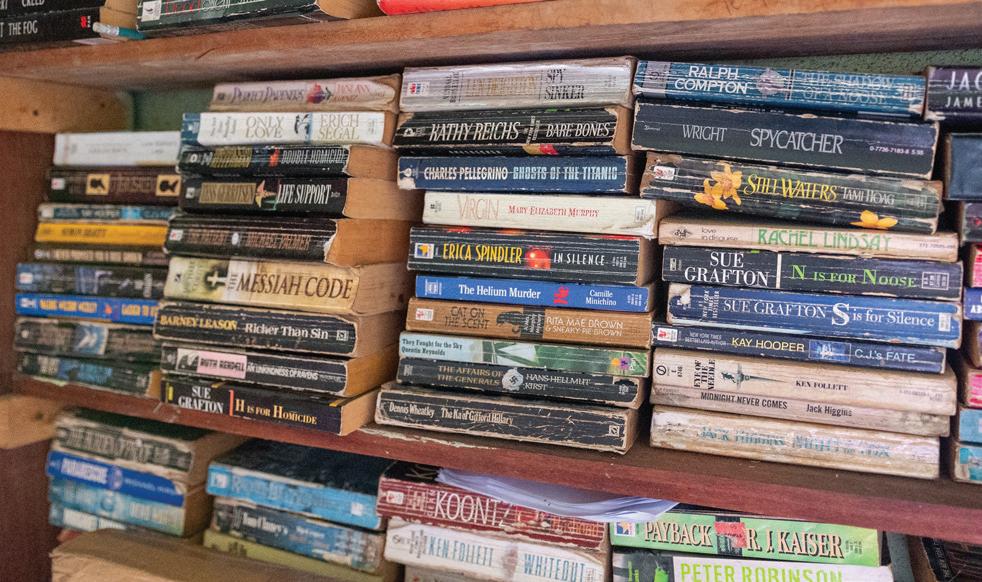

from that job, she wanted something to do to keep working; thus, the birth of the bookstore was realised.
With her very large book collection, she amassed over the years, Smith-Greaves knew she was doing the right thing because she

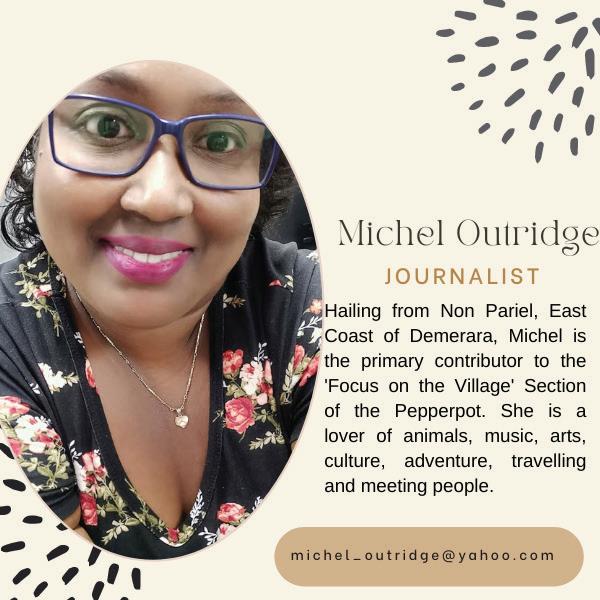
girls and four boys, she reported that they all developed the habit of reading at a young age and that prepared them for adulthood.
“When you read from a book, it stays with you, unlike when you download it from a computer or smartphone and reading for me is still fundamental,” she said.
Smith-Greaves stated that reading prepares you for speaking and how you go about relating to your daily life, and it adds instead of taking away, and it is a vital part of a person’s development.
wanted to share the joy of reading with others.
At Smith-Greaves’ bookstore, you can browse the wide variety of books there to choose from at a mere cost of $200 per book to borrow or exchange.
“It is simple: you bring a

book, you take a book and pay $200 per book, and I do have my regular customers, the ones that still read,” she said.
When asked if the business is worth it, she related that it isn’t a high-traffic area, meaning not many people visit to exchange books to read or bring books but she has some customers and is keeping the doors open for them until it is possible.
She remembered that, as a young girl growing up in a household with many siblings, she had a lot of books and was never in need of them. They would read all kinds of books, even the ones they were cautioned not to.
But Smith-Greaves had already read all the children-rated books in their house, and back then, it would take just about two hours to complete reading a book.
Field, Sophia, and she would open her bookstore from 7am to 4pm except on Wednesdays, Sundays and holidays.
Smith-Greaves related that from time to time, people
Alexis Smith, 72, the eldest sister of Smith-Greaves who was at the bookstore, told the Pepperpot Magazine that reading is good and back in the day she would read three books per day and could completely read a book in a few hours.
Today, due to old age she would watch television more than read but she would still indulge in a book of her choice when the need arises.

She told Pepperpot Magazine that these days, she would still read and enjoy a good book, but she doesn’t do it like when she was much younger. However, her love for reading is still there.
Smith-Greaves opined that reading broadens your scope and increases your knowledge about many things, so instead of listening to nonsense, she encourages people to read more, talk less and spend time with themselves engaged with a book of their choice.
She is a resident of ‘A’
would stop by to donate books to her and gladly, she would accept since she never refuses free books to add to her collection.
Occasionally, she would buy books, but her main supply comes from donations from the public, and she is quite grateful for that.
Smith-Greaves has a collection of romance, thriller, mystery, crime, horror, and children-themed books, and she urges everyone to stop by and get a book to read when they have the time to spare.
As a family of readers, six
SmithGreaves’s book stall at Bourda Market in the city is the only surviving bookstore in the market and the few remaining bookstores and community-based libraries are drying up and closing.
Bookstores and shops, or be it a bookstall, is a safe space where people meet to explore their options, discover newer books and make purchases. It can be fiction, non-fiction, self-help, or educational materials, and a bookstore is where people can find all these options in one location.
Bookstores worldwide also serve as places where people can gather, discuss literature, attend author events, and engage with a community of fellow readers.
Bookstores are usually diverse, but most have something for everyone, catering to different tastes, ages, and preferences, it is a place for new experiences in books.
AS part of District 7030 Conference held in Guyana earlier this month, the six Rotaract clubs in Guyana participated in a community service project called DARE that allowed participants to engage in various impactful projects that would benefit communities.
Held at the Guyana Marriott Hotel and titled “Destination Guyana,” the 38th conference saw participants from 17 countries and featured training sessions, tours, and DARE: D: Diverse but unified; A: Agro-n-me; R: Rota love and E: Enriching my mental health.
According to Kimberly Manbodh from the Rotaract Club of Georgetown, the main sponsor, Republic Bank (Guyana) Limited, along with their Power to Make a Differ-
icably resolve conflicts and choose peace, as well as an upcycling project where old tyres were colourfully painted and reused as flower plant pots around the playground area.
Running concurrent to the project in the Zoo, some of the attendees journeyed to the One Guyana Shade house at Mon Repos, East Coast Demerara, to participate in planting sweet peppers; they also got to benefit from a tour at the Victoria Greens Hydroponics Farm.
To culminate the momentous day, Rotaract attendees gathered at the National Park to commemorate the installation of a mental health bench in collaboration with Desert Flower Guyana, a non-governmental organisation that
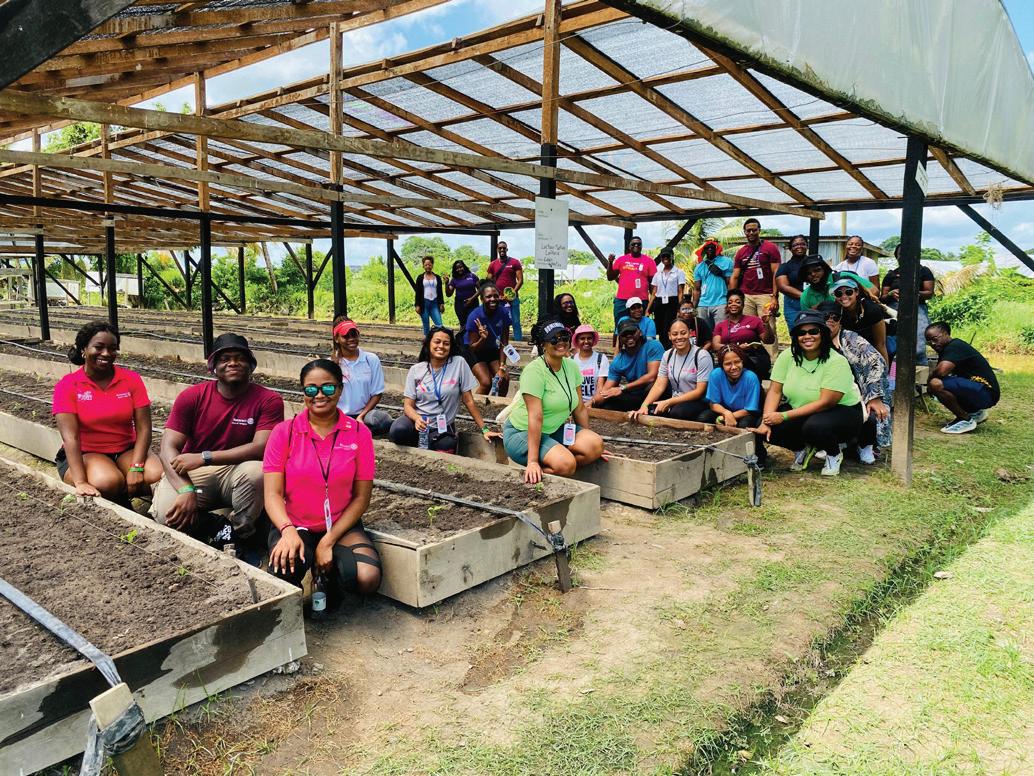
ence volunteers and Rotaract conference attendees played a vital role at the Guyana Zoo and Wildlife Centre where they painted a mental health mural (wall) to promote and raise awareness of the importance of caring for one’s mental health.
There was also the creation of a peace path that gave a guide on how to am-
deals with mental health.
This is the first of many to be placed around the park in order to allow people to reflect and find coping mechanisms to get through a difficult moment.
“Special thanks to the Guyana Zoo and Wildlife Centre for allowing Rotaract to serve the Guyanese community in such an impactful
way,” Manbodh said.
The National Agricultural Research and Extension Institute (NAREI) also provided flower plants and soil, while the National Park under the Protected Areas Commission provided a space for people to feel free to talk about mental health.
Rotaract is the youth arm of Rotary International, which comprises young adults from age 18 to 35, with a mandate to foster community development through service, nurture leadership and professional skills and network with other like-minded organisations.
The District 7030 Conference was held from June 13 to 17, with participants from within the Caribbean and South America sharing in workshops and enjoying the Guyanese cuisine and culture.
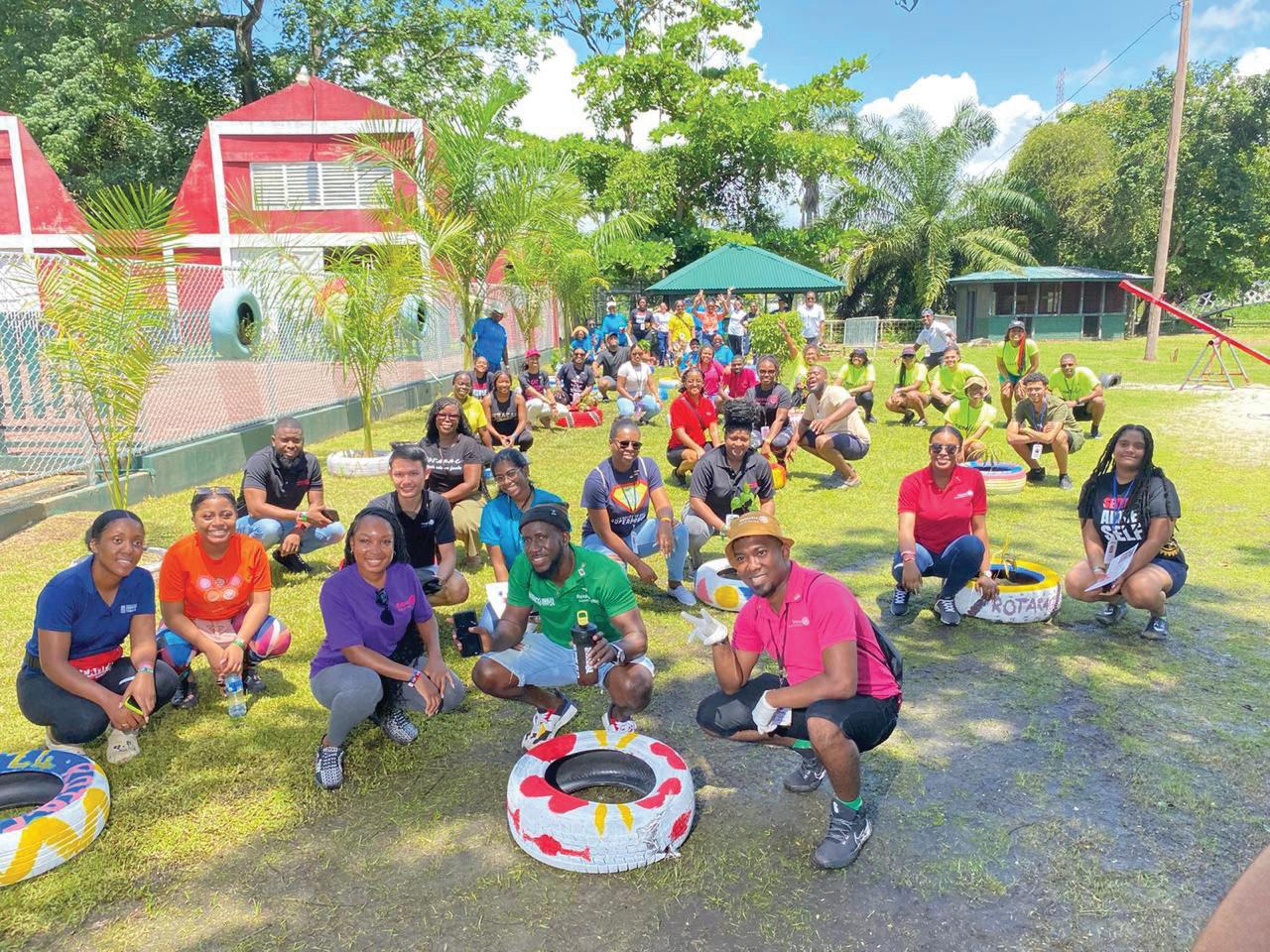
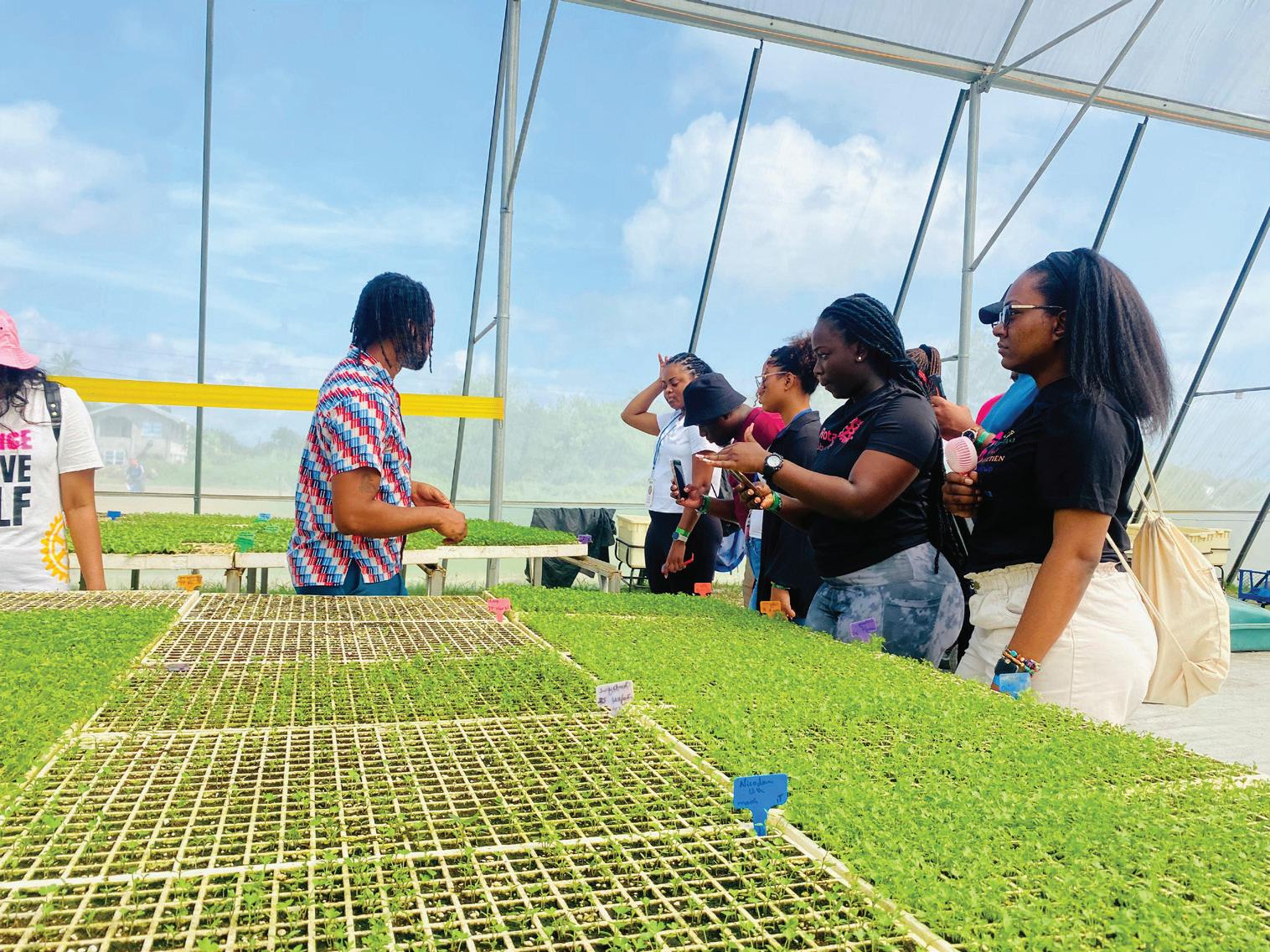
At the opening ceremony, members of the Rotaract clubs were challenged to continue influencing others and positively impacting the
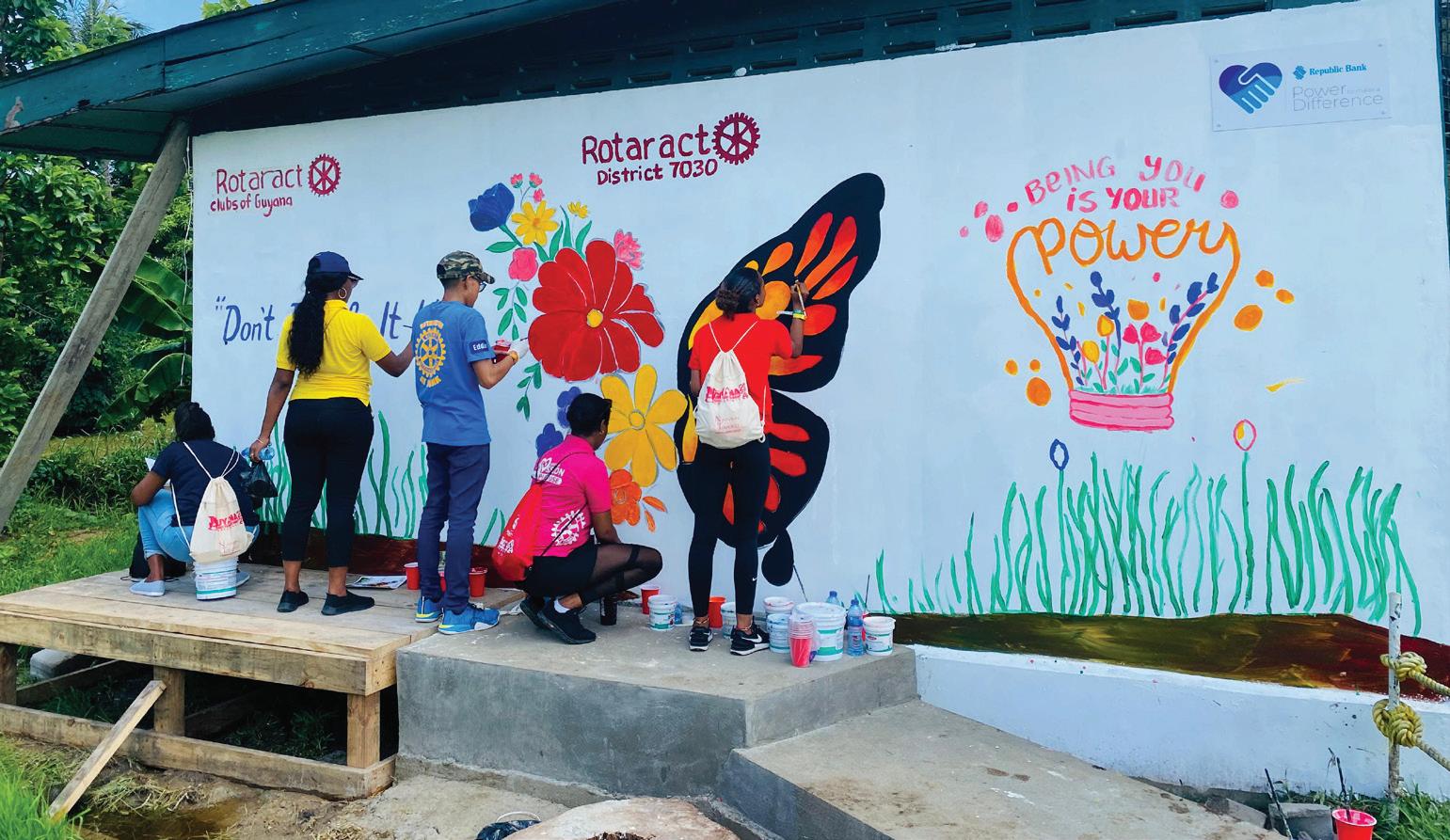
communities they serve.
“Anchored in the concept of service above self, your clubs inculcate in their mem-
bers the sense of something greater than the individual. They emphasise the philosophy that we live in communi-
ties, and in order for our communities to thrive, we must serve the greater good to better our collective well-being,” Minister of Tourism, Industry and Commerce, Oneidge Walrond, remarked.
While pointing to several youth initiatives of the Government, such as the President’s Agriculture and Innovation Entrepreneurship Programme, the minister said young people are key to the country’s long-term development and sustainability.
“My message to each of you is that, in your individual sphere of influence, you can help define the future through intentional action.”
“Your organising and sustaining events like this conference serve as evidence that young people are more than capable of taking charge and making a significant impact,” the minister continued.
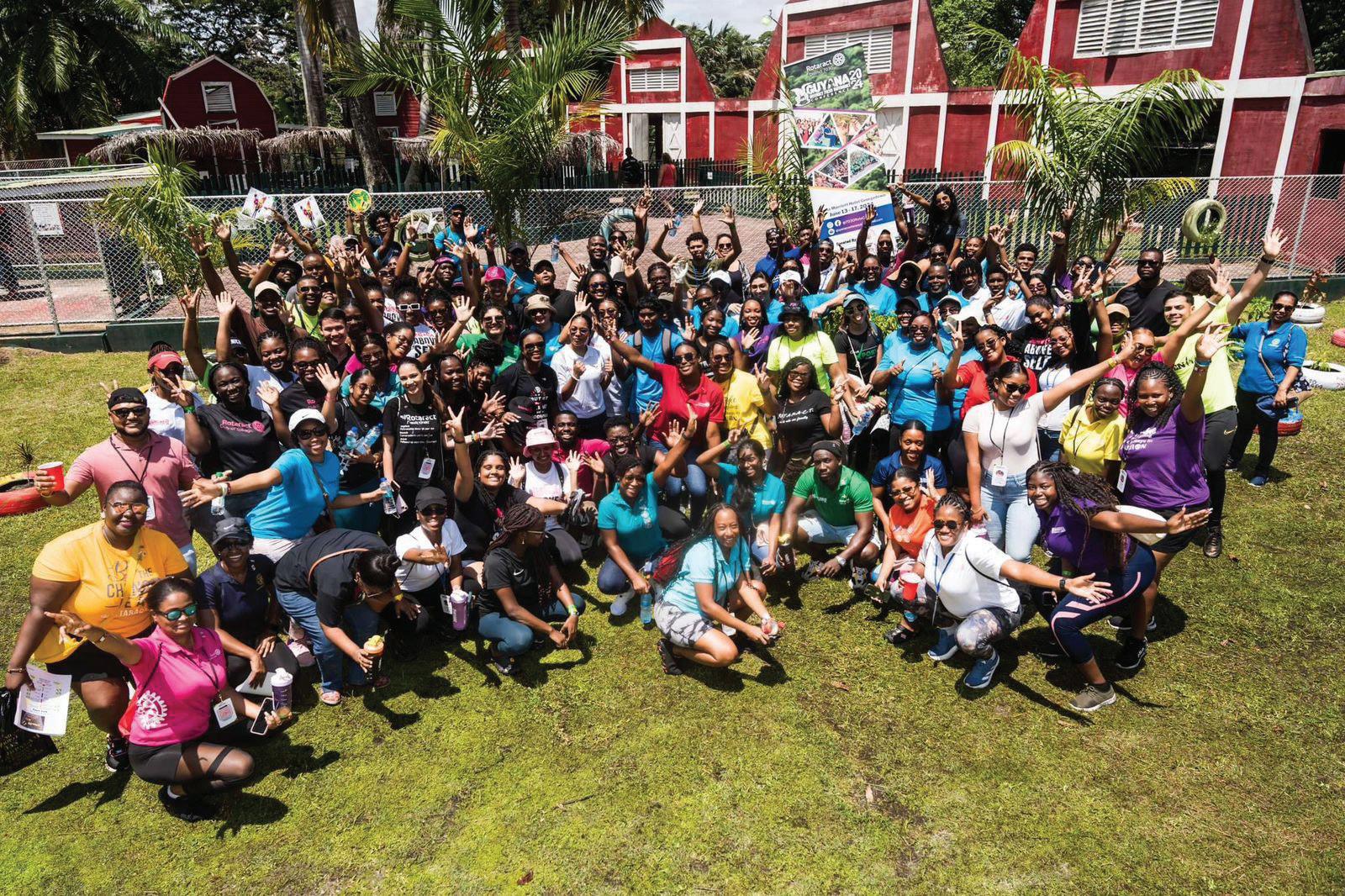
By Shaniya Harding
IN September of last year, one of the most unique initiatives Guyana has seen, the Guyana Together campaign, began with a focus on tolerance and acceptance. Since its inception by SASOD, the campaign has helped many people share their stories of support. This week, Pepperpot Magazine explores one such story.
Whether through challenging times or life-changing events, being there for family is crucial for most people. Many in Guyana’s LGBTQIA community lack this deep and profoundly significant support. As Pride Month draws to a close, Pepperpot Magazine spoke with siblings whose bond is so strong it crushes barriers.
Kaisha and Tarique Davis were not particularly close growing up with their extended family. Today, however, their relationship is as strong as ever, blossoming into a profoundly supportive bond. That is why, when Tarique came out as transgender several years ago, Kaisha was among the first to support him—and she continues to do so today. Kaisha and Tarique spoke to Pepperpot Magazine about the importance of support.
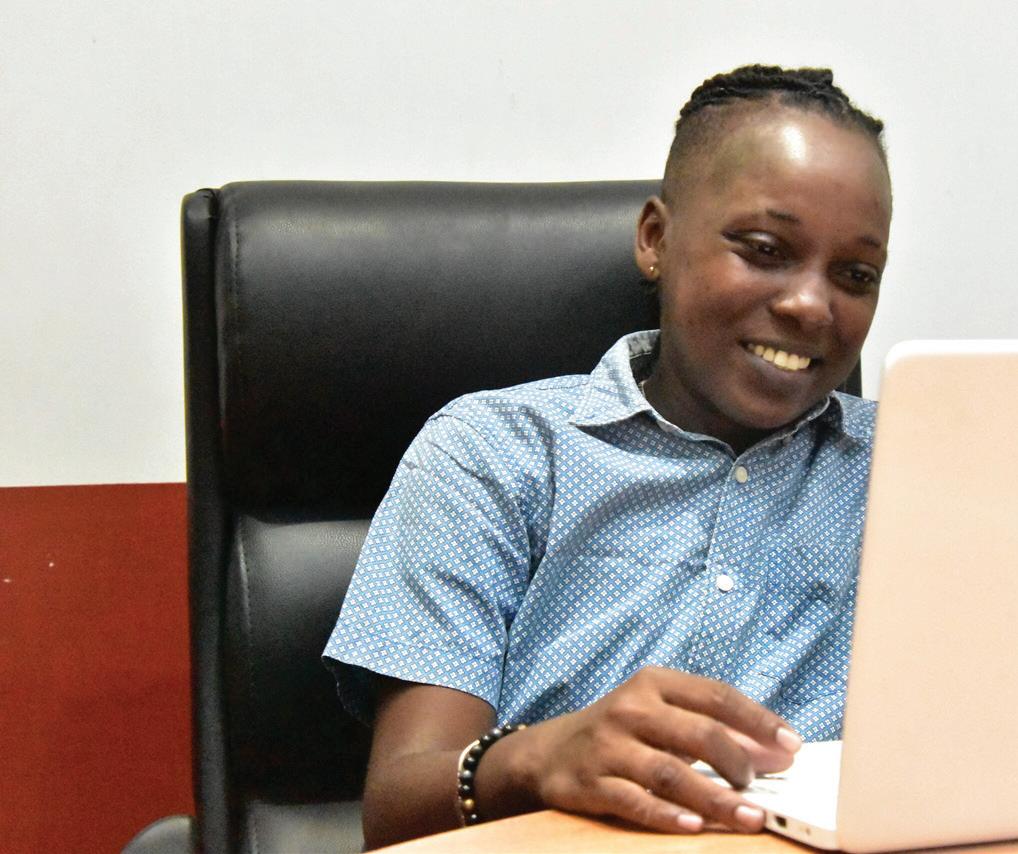

would love him regardless.”
Tarique shared what he remembers about coming out to his sister. As he stated, “I’ve never came out. I was just, I was myself and I would have been very stern, like, listen, this is who I am. Identify me as this… when you’re talking to me, these are my pronouns. So, the way I dress and everything, yeah, would have affirmed everything.”
Kaisha and Tarique came from a middle-class extended family on the East Coast Demerara. Despite a few ups and downs, their childhood was good. “We didn’t always grow up together. Tarique came to live with us when he was around six or seven, after his grandmother passed away. Since then, we’ve lived with our mom on the East Coast.”
Their relationship evolved over time. When Kaisha gave birth to her first child, Tarique was there for her. “When I was having my first daughter, Jaz, I couldn’t have asked for better support than Tarique. Interestingly, my eldest daughter shares many of Tarique’s characteristics—she’s a perfectionist and very competitive.”
Tarique’s support was crucial for Kaisha, and for the first time, they formed a relationship beyond their childhood. She explained how Tarique offered a unique perspective, saying, “During some marital issues, Tarique was the only person I could talk to without fear of judgment. He’s more open-minded and tries to understand things from different perspectives.”
When Tarique came out as transgender a few years ago, Kaisha was taken by surprise. “Initially, because I was so unaware of what trans is. I didn’t understand.”
However, Kaisha was adamant that she would support Tarique the way he supported her. She further added that, “In my mind, I’m thinking regardless of if Tarique is trans or not, Tarique is my sibling, end of the day. Tarique is my sibling. I don’t care who Tariq decides to love. Tariq is my sibling, and I

Throughout the years that Kaisha has been an active ally of Tarique, she says she has learned almost as much as Tarique has. However, the biggest challenges she sees are the lack of representation of people like Tarique. As she shared, “I think that we don’t have enough exposure towards the LGBTQ community, and we don’t have the knowledge base, basically, to help educate society. So, because of that, I think it’s because we don’t know about it, we don’t understand it.”
Tackling Misconceptions
Misconceptions are what Kaisha and Tarique are working to change. As Kaisha explained, “I think the biggest misconception is that if somebody is trans, if they’re gay or bisexual, whatever it may be, that it can level off. That they can rub off onto someone else and that they can pray it away… Somebody always want to say, ‘you should pray more’, ‘you should do this more’, but how can you tell someone that when you don’t know their psyche, when you don’t know their history, what they’ve been through, their journey in order to get where they are actually?”
Today, Kaisha is just one of many people in Guyana right now who are part of the Guyana Together Campaign, an initiative working towards fostering tolerance, inclusivity and support to members of the LGBTQ community. Support is extremely relevant, says Kaisha. “Support is so important because if you don’t get the support from your family - and I can say that Tarique went through this himself - you feel like an outcast. You feel like people who were put on this earth to love you, they don’t, and that can hurt a lot. So having family there to support you is very, very important. And sometimes it may not be your blood relative that is the one that’s going to support you.”
Tarique shed light on what this support personally means. Saying, “My sister’s support means a lot to me…because just being a minority, you are part of a community, but you’re still in the minority of that community... So, the support of my sister [is important], just because persons would not be, educated on the topic…Even persons that are part of the community are not really educated on, like, what it is to be trans, what it means to be trans. So sometimes we face discrimination in there.”
Love them for who they are
Kaisha and Tarique are part of a larger, glaring topic that is true acceptance. It may be in our culture to be sceptical of those who are different. But Kaisha urges everyone everywhere to love those around you, feeling for what makes them human and not what makes them different. As she said, “I would say that like, regardless of their gender and sexuality, you should be able to love a person for who they are, for their characteristics, for the things they do, for the way they are. Just love them and stop loving what society thinks they should be.”
SIX secondary school students were chosen from among 120 to receive music kits in the ‘Kross Kolor’ Music Producer Incubator Programme, having undergone training in music production and recording engineering to become independent emerging producers, capable of creating professional-sounding rhythm tracks.
Director of Kross Kolor Records and veteran music teacher, Burchmore Simon, who led the training, told Pepperpot Magazine that all of the objectives were achieved. Of the 120 interviewed, 30 were shortlisted, and the final six were presented with kits made up of music production equipment. Notably, one of the winners took
ware. It also featured audio engineering basics for sound recording, music marketing basics, and understanding the functions of music industry specialists like producers, arrangers, publishers, road managers and music managers.
In coming up with the idea to train the youngsters in this manner, Simon said he thought of the fact that most producers and studio owners only focus on recording music. “In my opinion, they don’t look at the longevity of the industry. For there to be longevity, you have to get young people coming into the industry with skills that are relevant,” he shared in an interview with Pepperpot Magazine.
On a more practical side

home a keyboard presented to the Ministry of Education by music sensation ‘Bussy Signal’.
The course covered basic music theory and the use of keyboard controllers to make rhythm tracks within standard music creation/audio soft -
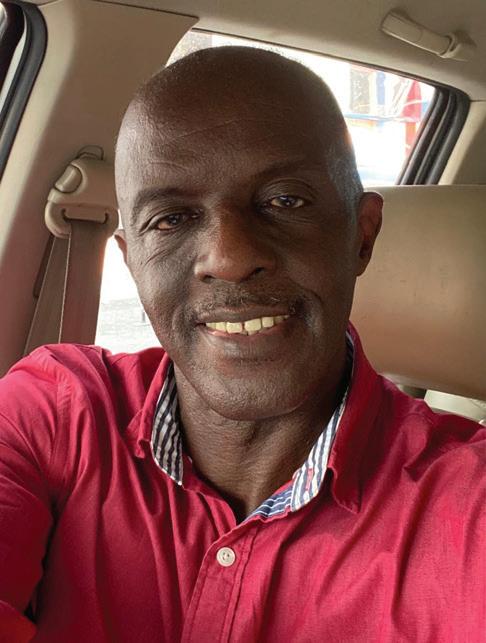
of things, he said the youths must also be provided the tools to develop those skills, hence the idea to present them with a production studio upon completion of the training.
“I believe in education in the music industry; in the
creative industry generally and all the grants that I’ve had so far have been for the training of people; the grants were never about me. My main motivation is the passing on of my knowledge to the people of Guyana and equipping them to be creative and start their own business,” Simon expressed. And it doesn’t end here for the children. “From this, they will have a lifetime partnership with Kross Kolor in that we will always be there to guide them and help them along. So it’s not that we train these kids and leave them on their own.”
The Unit of Allied Arts in the Ministry of Education (MOE), which is responsible for expressive arts in schools, greatly assisted with the project and Education Officer – Music Joel Gonsalves said the MOE was the host location and was responsible for auditions, along with monitoring and evaluating the programme.
Head of the Unit, Nich-
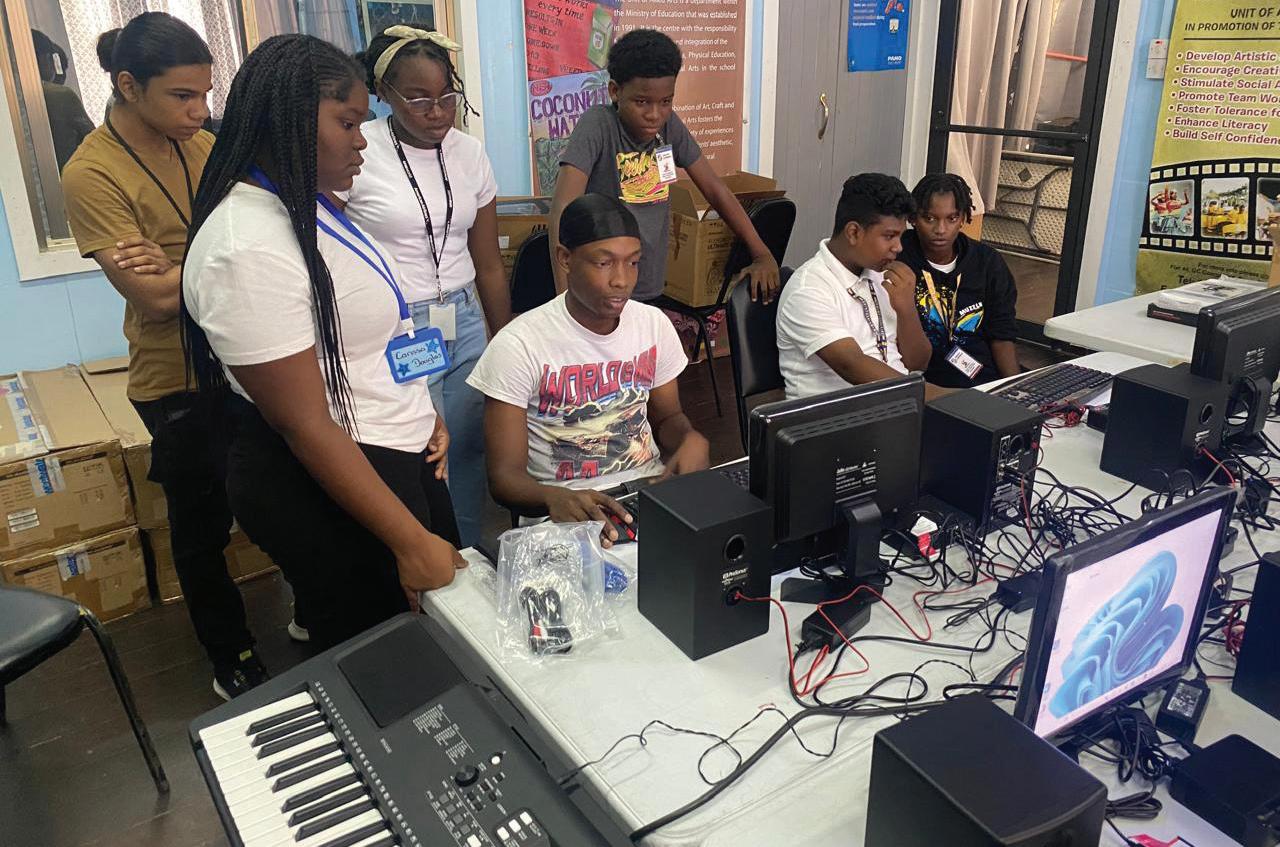

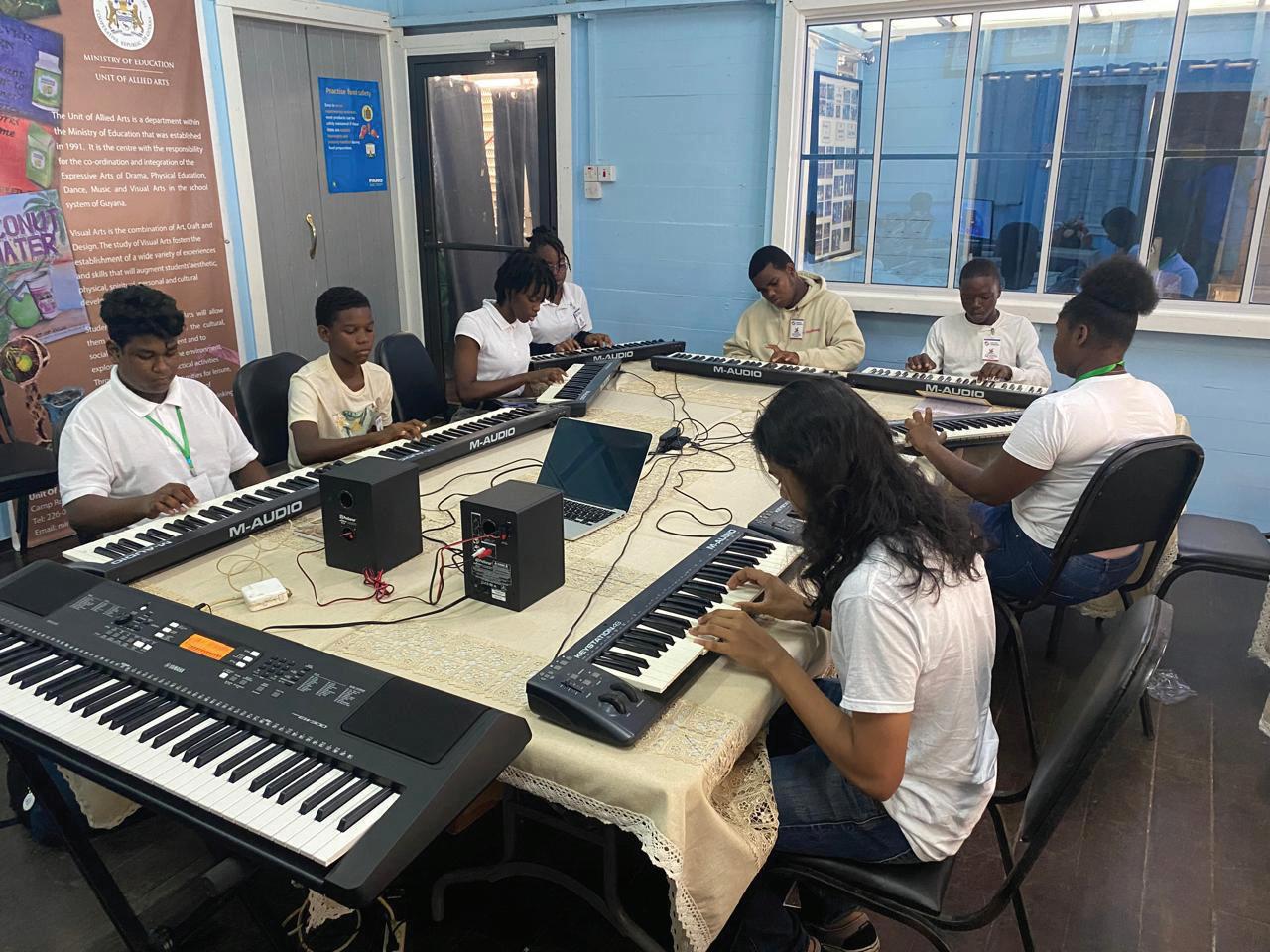

olas Fraser, was especially supportive throughout the programme. “Anything we
needed, we just called on him, and he was willing to lend support,” Gonsalves related, adding, “We were happy when the approach was made by Kross Kolor, and since it is a unique idea towards music in Guyana, we felt that it was extremely necessary to be a part of the programme.”
Sixteen-year-old Tasiyelle Paul of Hopetown Village, West Coast Berbice, didn’t know at the time of her interview with Pepperpot Magazine that she was among the six winners. “I am hoping and praying that one of those kits would be mine,” she said.
“The course offered me
a safe space to express myself; it improved my musical knowledge and gave me a lot more new talents and skills. What I enjoyed the most was the people that I met there. It was like a family; it was the togetherness of it. The training from Mr. Simon and others was amazing.” She wants to use her kit to promote positive music in her community and help others who are interested in the industry while at the same time advancing her own goal to become a singer. After the training, though, she decided she wanted to add something to that goal. She now wants to become a producer.
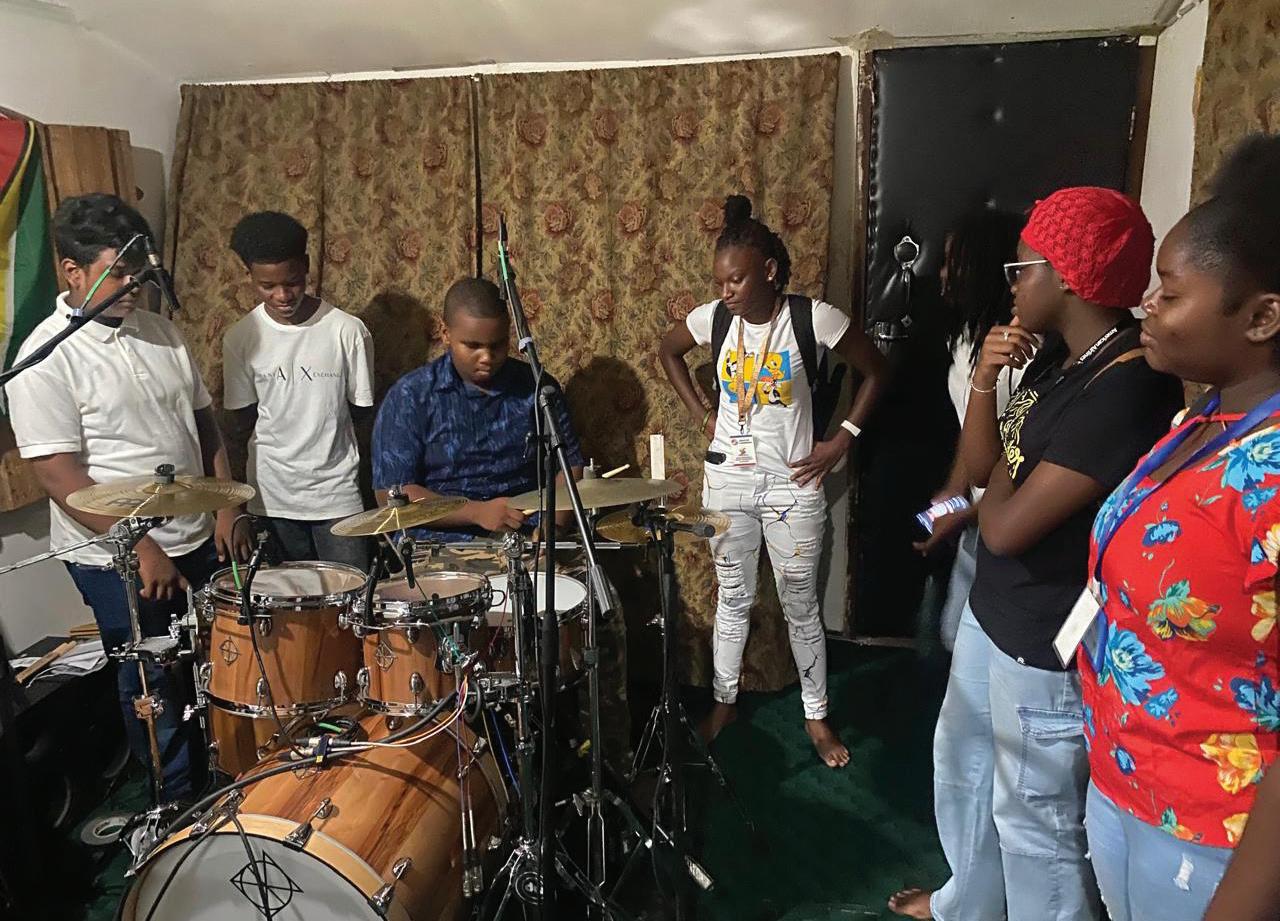
PROSPECT Village, Mahaicony, is a small community that is home to less than 50 people. The community is more farmland than houses, which creates a unique tranquillity. When 25-yearold Dolly Sooknanan moved to the community just a short time ago, she never thought she would become so accustomed to the silence. However, like everything else, there are challenges.
An area many may consider remote compared to its livelier counterparts, life in Prospect requires a bit of adjustment. Prospect is a small community with very few people and even fewer sights to see, but it does present a unique set of challenges. Villagers say these challenges are worth it for the peace of mind that Prospect offers.
Dolly is a wife and mother of three happy and energetic children — two girls and the family’s most recent addition, a two-month-old son. Born and raised in Helena Mahaica, Dolly did not think the move to Prospect would bring such a major change. As she stated, “We moved here almost a year ago. We had always lived in Mahaica, but my husband recently built here, so we moved. Growing up in Helena was good. Here in Prospect is different, but it
is good, too.”
Growing up in the hustle and bustle of Helena village, Dolly was not very interested in agriculture. This changed when she moved to Prospect. As she recounted, one of her first memories of Prospect was seeing the rice harvest up close for the first time.
“We live next to a rice field. Honestly, don’t even ask me about rice. When we came here last August, the rice was already big, and it was the first time in my life I saw how they cut the rice. Living on the main road, we never used to go down to the back to see the rice. I don’t know much about rice. I had never seen rice before. Now, living in Prospect, I find it very peaceful.”
But peace does come at a cost. As Dolly explained, Prospect’s greatest aspect is also its main challenge. Life in Prospect can be somewhat challenging when tucked away, far from townships and shops. As Dolly stated, “When we moved here, my husband had to fix the road. After the rain, he had to get a loader and repair the dam. The shop here is a challenge, too. It’s not easy to afford a taxi. The taxi charges $1000 just to come, pick you up, drop you off, and then you need another $1,000 to come back. That’s $4000 for a taxi
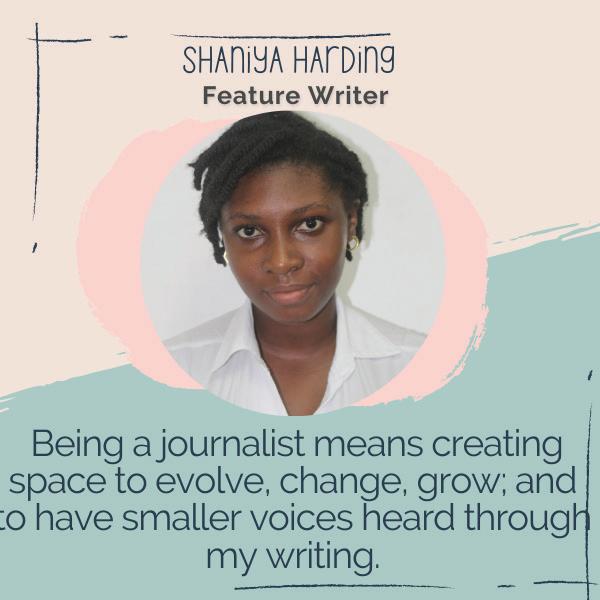
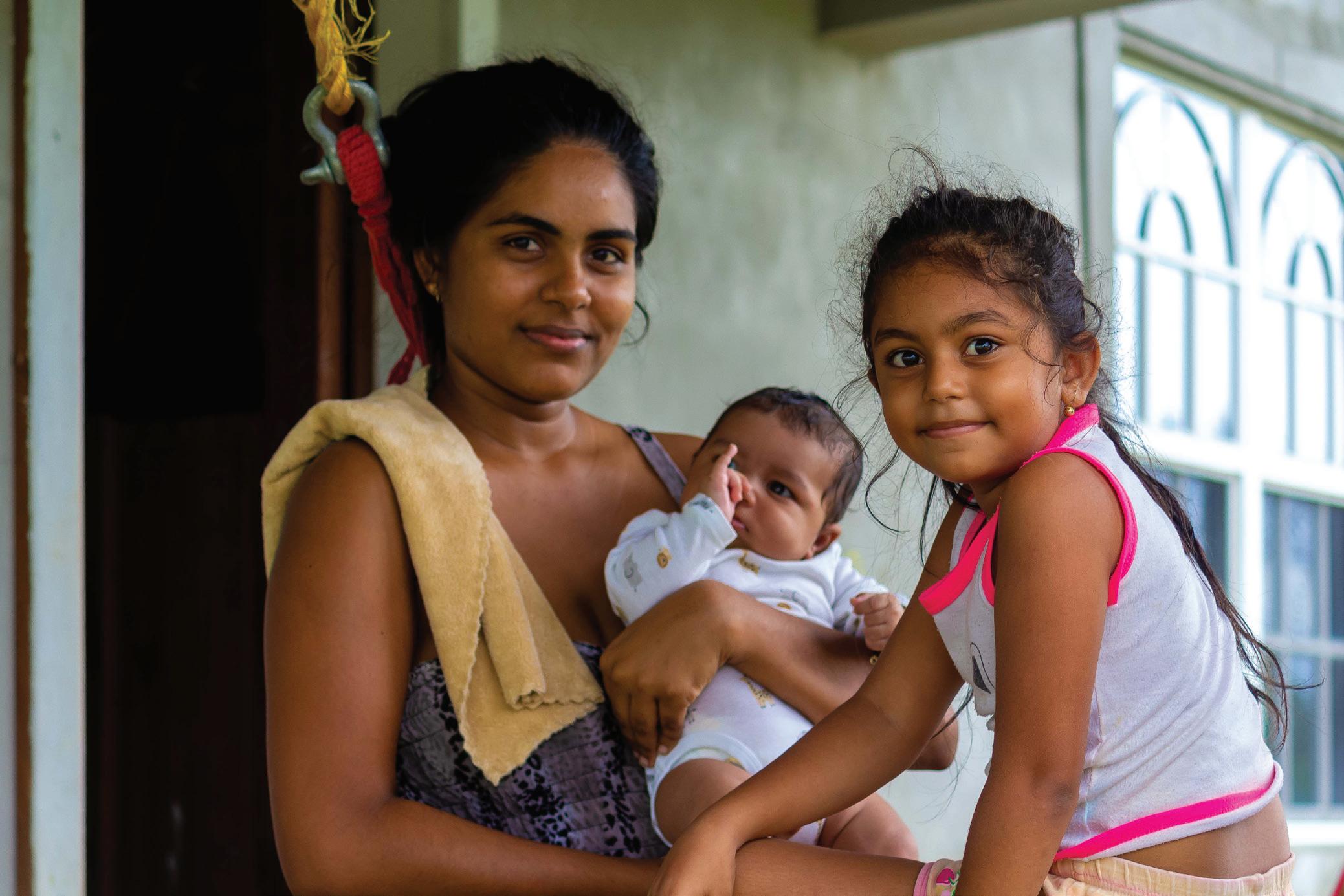
in a day. We had to move our daughter from Helena to Carlton Hall because this side is closer.”
Peace and quiet are welcomed, Dolly says, and her biggest balancing act currently goes far beyond Prospect’s streets. “It was hard when we first moved here because I’m

to Mahaica. We used to travel every Saturday to go to the market, get stuff, and come back. It was challenging, especially with a little baby. Now, the hardest part is balancing everything: waking up early to hurry with the older ones to take them to school, drop them off, come back, then you have to hurry through your house chores, cook, and then plan the timings to go back to collect them from school. The most challenging thing for me right now is balancing everything.”
Although still relatively new to being a mother, Dolly has made significant strides in her journey. She has learned a lot and has had
to manage much more to care for her children when her husband works long hours.
“Sometimes my husband isn’t around. He works right across the road, but he’s not there every single day. They’re working on contracts on the road right now. It’s very important to be independent because you have to handle everything when he’s not around. My father helps me out when he’s around, but when he’s not, you have to manage everything alone. You have to put the little one in the car and focus on the road and the kids. It’s challenging.”
Dolly further adds that she does things now that she never thought she would
be doing. She explains the challenges of caring for her children when her husband is at work. As she stated, “My daughter used to go to Helena, but it was hard to carry her every morning, come back home, then go back at 2 o’clock. The family support from my husband is nice. He helps when he can, but it’s challenging when he’s not around.”
True to her nature and spirit, Dolly has taken tremendous steps in caring for her family. She shared that there were many things that she had to learn. Today, she is happy in her community of Prospect and would not trade the peace and quiet for anything else.

By Shaniya Harding.
“Dull but peaceful” is a popular sentiment shared by the people of Prospect. It is easily one of the simpler places in Guyana, with a small population heavily focused on agriculture. The people of Prospect, however, are anything but dull. Among them is Deveia Hookumchand, a longtime villager. A devoted mother and wife, Deveia shared her story of the countless challenges life presents and how the peace and quiet of Prospect offer a unique perspective.
Although she described it as boring, Deveia shared that growing up in Prospect was good. It made for a childhood filled with playing and experiencing the community at length. Deveia and her two siblings found ways to entertain themselves with no phones. According to most villagers, Prospect is even smaller than it seems. She explained that most of the people in the community are related, if not by blood, then by marriage. Prospect seems to be the place where most people settle down.
As she stated, “I grew up in Prospect. I remember it as a dull and quiet community. And it still is, very dull and
very small. Everyone here is family, though, so everybody knows everybody. Most days I stay home, cook, and clean with my husband and children.” She has spent most of her life in Prospect. After growing up in the community, she got married and started a family of her own. Deveia and her husband later moved to Rising Sun, a more populated and lively community.
Deveia further added, “When I was young in Prospect, a child growing up, I was at my mother’s house. That was before I got married. I would spend time with my brother and sister just in the village. Then I got married at 19, and then I had my eldest son. I met my husband through a matchmaker.” The two are married more than 30 years later and reside and farm at their Prospect home. After a few years of marriage, the pair settled in Prospect after venturing to places like Rising Sun. The community was a change of pace from the excitement they were used to in Rising Sun, and Deveia admitted she missed the constant bustle for a while. One thing that has captivated her about the community, however, has been the loving relationships between people. A diverse
community, Prospect is as welcoming as it is tranquil. As Deveia stated, “The relationships between different people here are very nice. We grew up with them. We’ve had a long way with them and until now, we live like family. We never looked at race. Since my father’s time, that’s how we have lived.”
The people and peace create a unique, safe space in her time of tragedy. Several years ago, Deveia and her husband lost a son, a young and ambitious man who passed away in a road accident. Although she does not like to think back on his passing, Deveia shared that she often finds herself thinking about her son, the good and bad times. “He was 24 years old. I do not always like to think about him. But when I do, sometimes I laugh, and sometimes I cry. And sometimes it makes me nervous.”
The incident left Deveia with a perpetual sense of nervousness, she stated. She explained that in the years since then, the memory has had a profound impact unlike any other. As she stated, “When I think about him, it makes me very nervous. Sometimes, I just get nervous thinking about him, up until this day.”

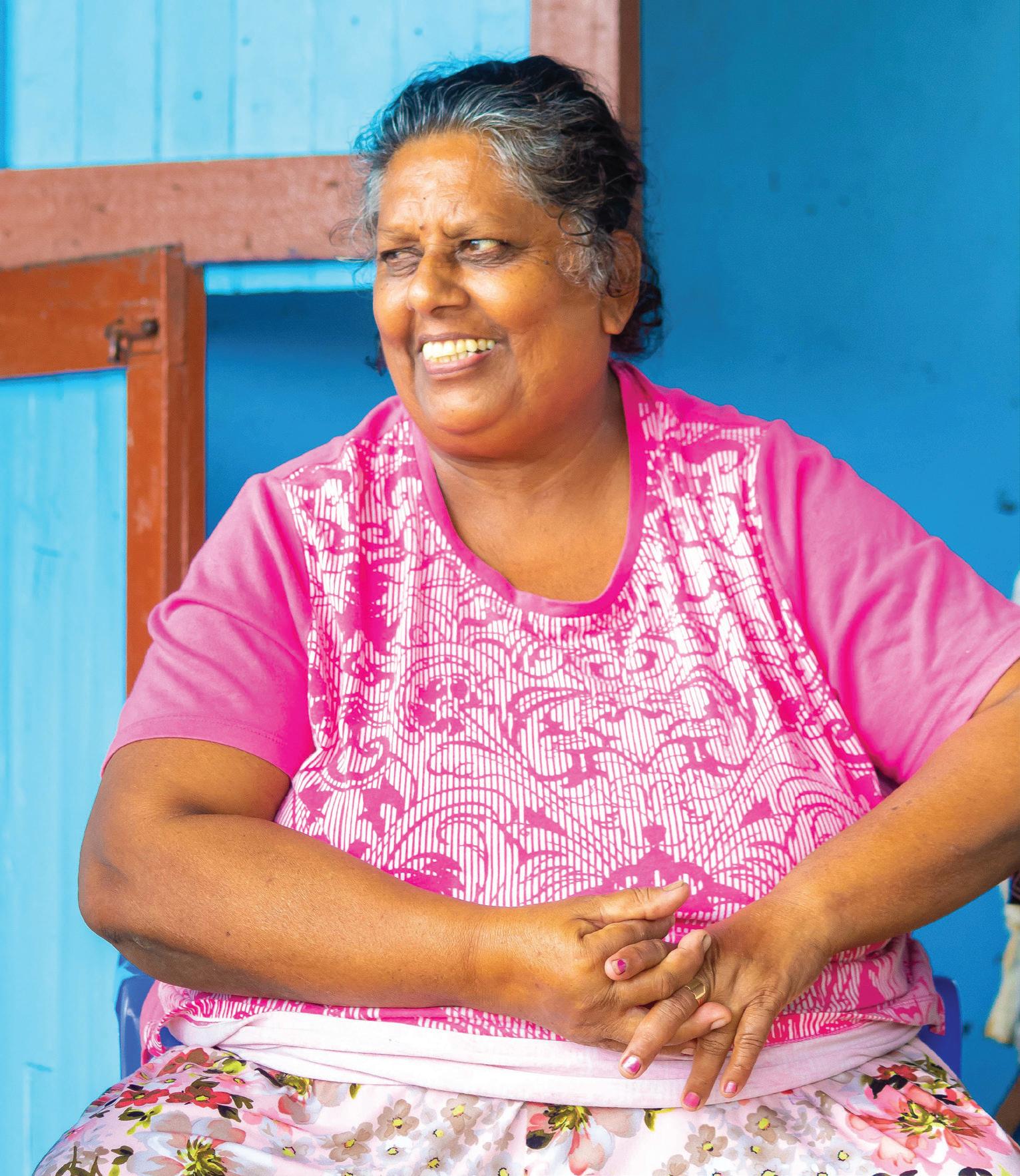
The feeling of losing a child is unexplainable. As Deveia puts it, “Only those who feel it know. But it is hard.” Today, she lives with her two younger sons in Prospect. The community is truly close-knit. Both sons have built their homes and families in Prospect, keeping each other close.
Today, agriculture and simplicity characterise Deveia ‘s life. She and her husband have been farmers for
many years, but in recent times, they have been doing less farming. Deveia shared that the older they get, the more they appreciate the peace and quiet of Prospect.
“We used to farm a lot, even rice farming too. But we have gotten old now, and it is harder to go to the farm every day,” she stated.
Prospect may not stand out among the green fields of Mahaica, but it is home
to a unique, seemingly healing kind of peace. Although Deveia would like to see more activities implemented in the community, she greatly appreciates the tranquillity. As she stated, for her, these days are just about “You have got to take life cool. Everybody is doing a little planting or raising livestock. You just can’t fight it, just take life as it comes.”

‘It‘s
By Shaniya Harding
PROSPECT is what many would call a pit stop along the Mahaica road. A farming community, the village covers little over a mile. A quiet and easy-going place, there is not much to talk about in the village. But among the rice fields, tractors, and grazing cattle, Savitri Jorree’s home and business stand out. More commonly known as Mala, she is among the few small business owners in the community and owns the only snackette for quite a few miles. The Pepperpot Magazine sat down with Mala at her Prospect home, where she shared her journey of entrepreneurship, marriage, and motherhood.
The village of Windsor Forest is a long way from the farmlands of Prospect. Mala was born many miles away in Region Three, Windsor Forest, a quiet little community that looks out on the water. Mala remembers her life then as quiet and filled with all the simple joys of early childhood.
As she reminisced about her childhood, Mala shared, “In our days, it was different. We did not have all these kinds of things, like phones. It was not so modernised. It was basically school and home. I grew up [and] went to Windsor Forest School. From there, I wrote my Common Entrance exams and passed, going to Christ Church Secondary.”
The peaceful carelessness of her childhood ended soon after high school, as Mala explained. She met her husband at just 17, and the pair were married soon after. Contrary to meeting through friends or on their way home, Mala and her husband were an arranged match. The two were led to each other through family members who simply thought they would be a nice pair. As Mala stated, “I got married during the process of just finishing school. I was just around seventeen.”
After getting married, the newlyweds moved to the village of Prospect. The move was different but welcomed, as Mala said. Prospect was and still is a peaceful place and presented a tranquillity that she has learned to appreciate.
Today, Mala is happily married and the owner of a growing business. She has overcome countless challenges life has thrown at her in her fifty-one years. Mala says she has learned plenty throughout her journey and is determined to teach her daughters. The one thing she would tell her two grown daughters, however, is to get married for love.
Mala expressed the value of choice and learning to love someone rather than fall in love. As she shared, “For now, I would tell my daughters, find who you want and fall in love. Because you want them to know. Because I didn’t have that part in my life. I didn’t have the part where I had to fall in love. So I wanted to experience it. Because if you fall in love with them, you have a choice. You stay with them, and you live. You go deeper into the relationship. You can make a stop right then. So then you have a choice.”
She further added, “Mind you, in marriage, you have a choice too. But then remember, you’re already married. You have a commitment. In a relationship, you don’t have a commitment. So you can say, ‘Hey, that’s it, I can’t stand you, you can’t stand me.’ But in marriage, it all depends on how you take it. If you want to dedicate yourself.” And Mala has truly dedicated herself to her family and, more recently, her business.
As a young mother, Mala and her husband faced financial difficulties like many new couples. Mala sought to help her family and began searching for new ways to contribute, among them farming. As she shared, “I planted callaloo for a couple of years. There was an old man next door who used to set a board. He would take my produce and sell it, bringing back the money.”
Mala recounted one of the most trying periods of her life: her pregnancy. As she explained, her business began as a way to provide for her children. “I sold pastries for a couple of

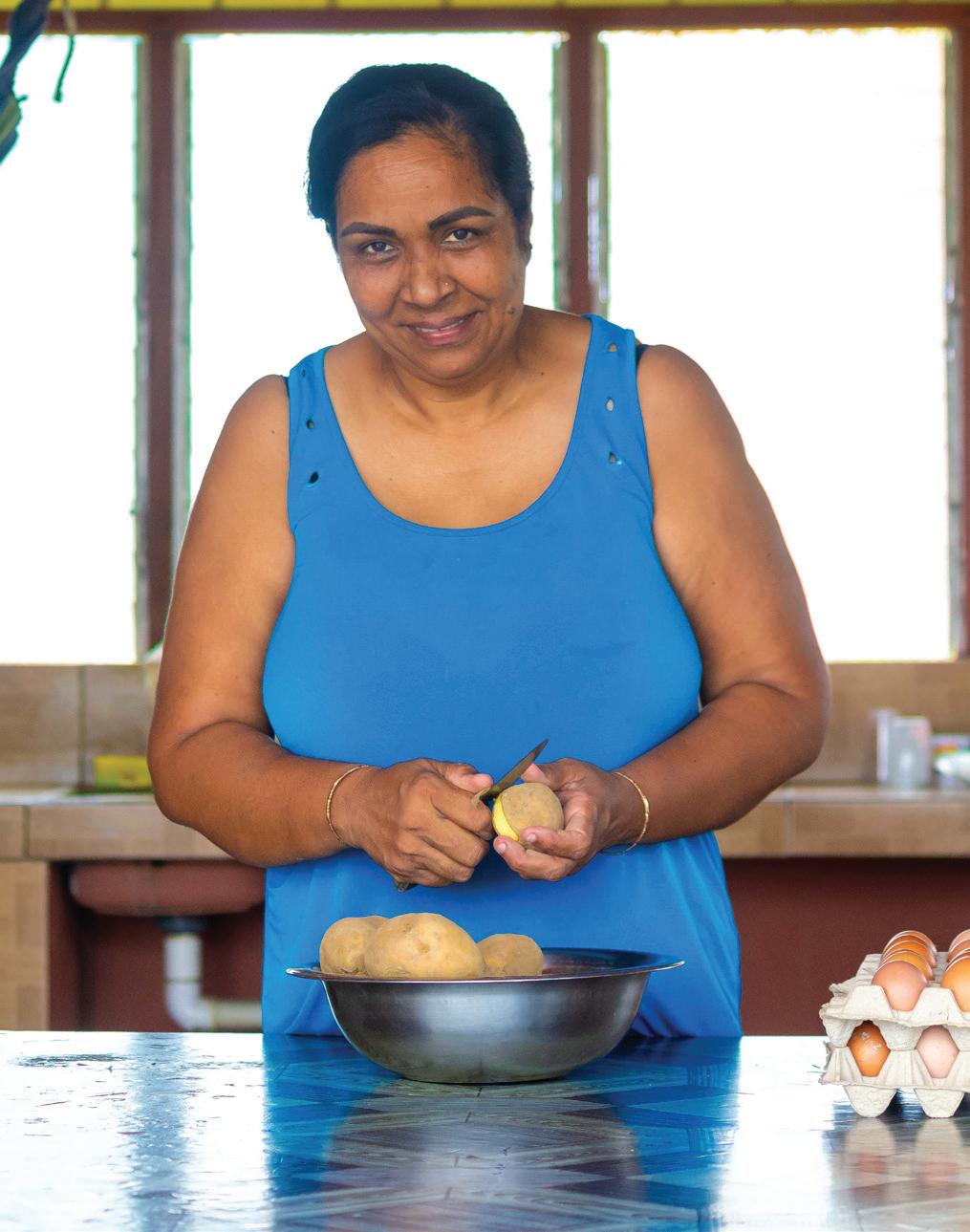
come home, go pick her up at UG in the night, and come back.” Mala admitted that initially, she had doubts about starting a business but eventually decided to take the leap of faith.
As she shared, “I was wondering what business I was going to do here because it’s not a populated area. I was like, if I make a socket, I can make a business. I built a little thing out on the road. I started to do eggballs to see if that was going to work. Then I realised a business could do well here.” In the last three years, Mala’s business has grown, as has her supporter base, with D and M Snackette becoming a well-known name.
Mala’s attitude towards business is similar to her approach to life, with quiet and unsung determination. As she shared, business is about contentment and going with the flow. “In any business, there are some days that are not

years. At the same time, my daughter was going to UG. I used to sell on the road,
good and some days that are good. And it is a challenge, but it’s all about how you take it.”

By Shaniya Harding
THERE are many sides to agriculture. On the one hand, there is the large, vibrant and industrial aspect of agriculture. On the other hand, small-scale farming is done at the family level with the goal of being self-sustaining. Regardless of whether it is a massive agricultural endeavour with tons of harvest or a family business with just a few crops on their community’s farmland, agriculture is a major part of Guyana. For the last three decades, lifelong farmer and plant lover, Frankie Hookumchand has called Prospect home. Born and raised in Mahaica, Frankie stated that agriculture has always surrounded him. “Growing up in Rising Sun it was farming mostly, most things like farming-- cattle farming and sheep rearing,
goat, pigs,” He said. “We used to sell pigs and cows for a raise. My family had a lot, we had over three, four hundred of them.”
Rice farming is an integral part of life in Mahaicony. Most people have dabbled with rice farming at one point or another, and Frankie is no exception. Apart from farming the rice, Frankie utilised the byproducts for his livestock. “When the rice is cut, you lose the animals, and they would go and eat the paddy in the field. We had enough sheep, though. We had enough sheep and goats. We had over five hundred sheep and two [to] three hundred goats.”
As rice farming became bigger in the region, Frankie and his wife shifted from livestock. As he shared, “I used to plant ten acres, I think. We had our own trac-
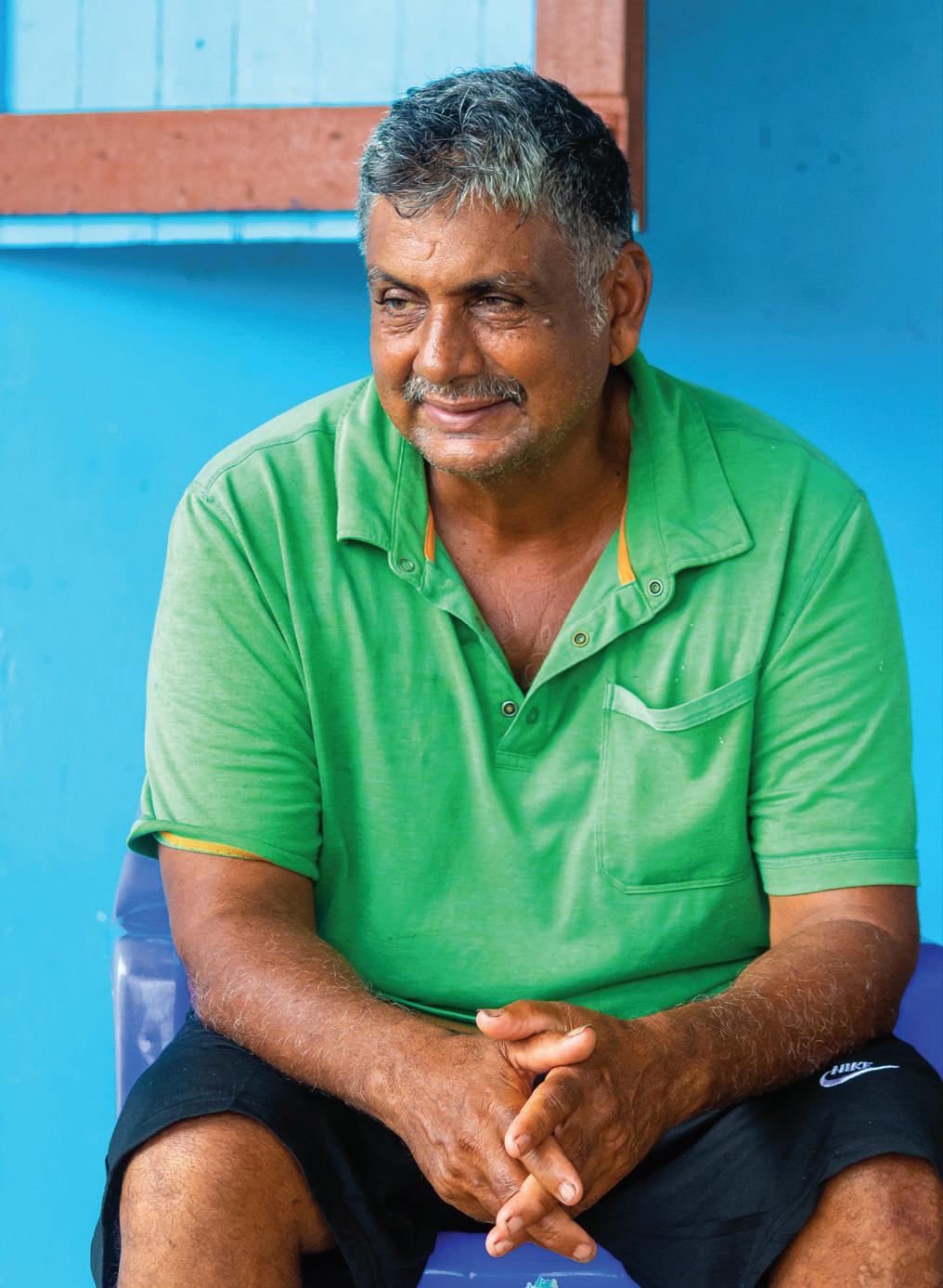
tor.” He further added that “The only challenge is this drainage. There is no drainage for the garden. Because back here is a rice field and all the water is lodged back here. The road drain runs at the back, so no water leaves the land, and it is blocked. That can’t be drained, so it cannot come right out.”
Emphasising the significance of agriculture to the region, Frankie says that agriculture has become a tradition. He shared, “Farming is a big thing in Prospect and gardening. The majority of people here use the pipe water for gardening.” He further added, “Agriculture is the most important part here. Because not a lot of people get employment they go into farming.”
After working with rice and fields, Frankie has changed pace with his 9 to 5 job. He still finds time for his garden, however. “But when I come home in the afternoon, I am still doing a little farming.” As someone who loves the land as much as Frankie does, it begs the question why he stopped at all. He explained that if it was not for a massive flood that happened some years ago, he would still be farming today. He explained that the sea defence had worn away, a long-time fear of farmers in the area that finally came to pass five years ago.
Frankie says the community has become better at managing the sea defence

over the last five years. “Now they are maintaining it right now. And they have put boulders and built back the thing.”
The loss the flood caused was unimaginable and devastating, causing the family to lose all of their crops and livestock. “I had to go and join the security force. I am now working with the security.”
He further added, “You don’t get back anything. You have to also do something else.”
Frankie went on further
to say that farming is not as risky as many think; the weather is often a farmer’s only contender. “It’s not so risky, but only when the bad weather gets over, you plant the leaves and you make the rain come in and catch you. And it’s not big, like 30, 40 acres.”
Since then, Frankie has retired from farming and now indulges in gardening.
He explained that plants and farming, to any extent, seem

to be a tradition in the community. “Well, since I came here, I’ve met them with this kind of thing. Cattle-rearing, sheep-rearing. It’s like a generation passing. So we continue with the tradition. It’s a tradition.”
Reflecting true contentment, Frankie says that living in Prospect is as easy as it gets. However, he would like to see more activities implemented for the children of the village. “Living in Prospect is nice. All I would want to see is something more for the children of the village, somewhere they could go and spend time.”
Today, in his 60s, Frankie is living life at its best. He works as a security guard throughout the day and comes home in the evenings to spend time with his family and his garden.




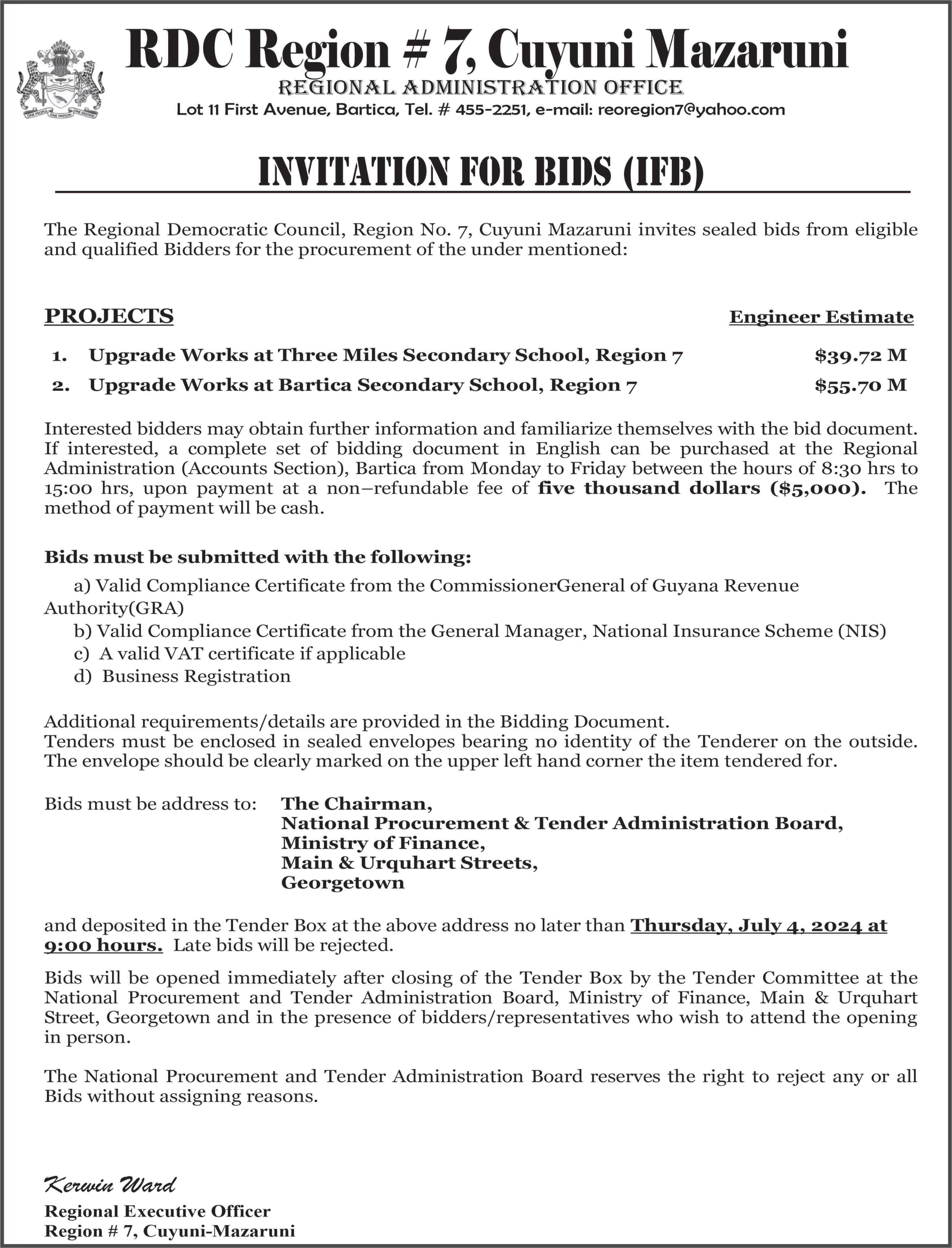


IN the year 1972, the United Nations General Assembly designated June 5 as World Environment Day (WED). World Environment Day is one of the foremost international days for the environment. This Global celebration adds important value to the Environmental Protection Agency (EPA) as it marks our beginning. The Environmental Protection Agency (EPA) was established on June 5, 1996, 28 years ago. We have been working tirelessly throughout these 28 years, actively engaging with local businesses and industries to promote environmentally sustainable practices to protect
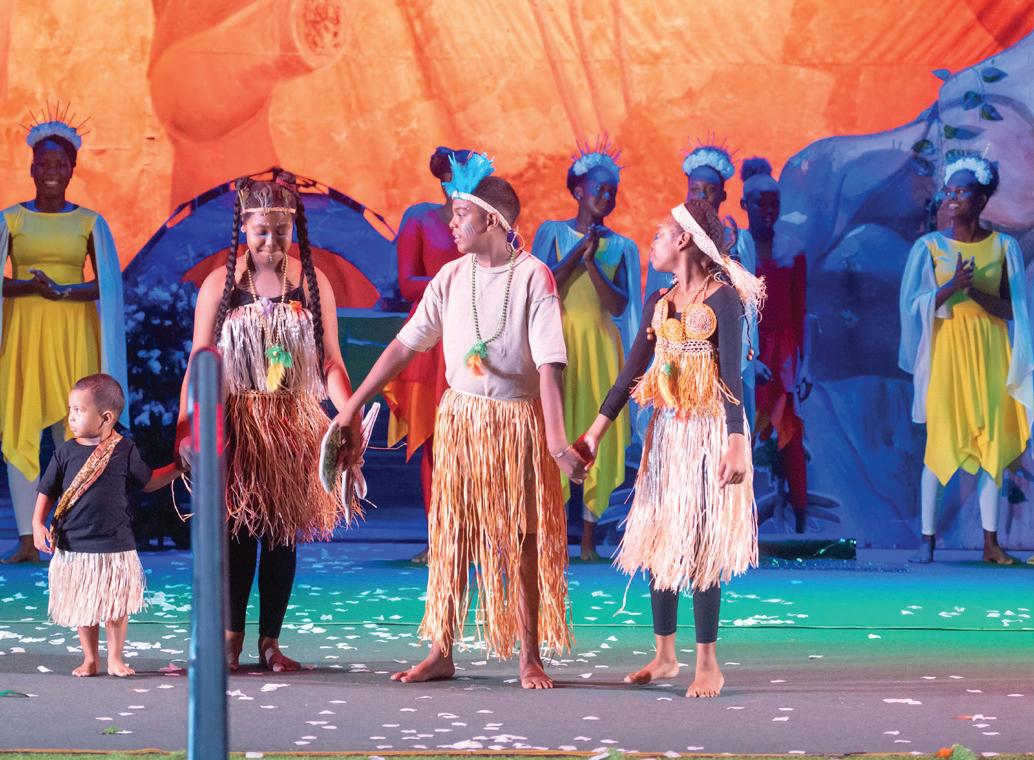
you the citizen and the wider environment. The theme for WED 2024 is “land restoration, desertification and drought resilience”.
Over the past five decades, the Day has become one of the largest global platforms for environmental outreach. Tens of millions of people participate online and through in-person
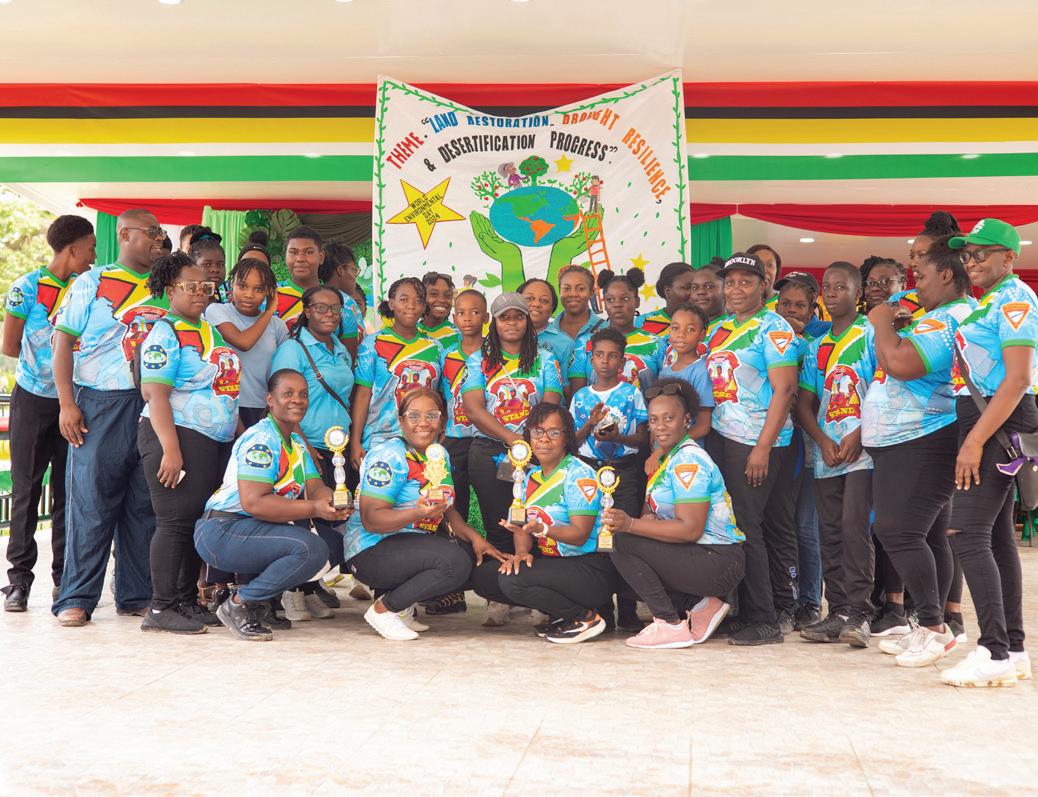
activities, events and actions worldwide. According to the UN Convention to Combat Desertification, up to 40 percent of the planet’s land is degraded, directly affecting half of the world’s population and threatening roughly half of the global GDP (US$44 trillion). The number and duration of droughts have increased by 29 per cent since 2000 – without urgent action. Droughts may affect over three-quarters of the world’s population by 2050.
Land restoration is a key pillar of the UN Decade on Ecosystem Restoration (2021-2030), a rallying call for the protection and revival of ecosystems worldwide, which is critical to achieving the Sustainable Development Goals.
Guyana is known for leading the region in taking a bold stand for the protection of the environment. This year, EPA

aims to highlight the country’s/Agency’s position in land restoration, preservation and protection while ensuring environmental sustainability and development. It will commence with the signature Green Walk, which will bring together all categories of stakeholders to renew their resolve to environmental protection and display their commitment to “land restoration, desertification and drought resilience”. In addition to the media programmes, the Agency will partner with agencies such as GLSC, GGMC, CDC, GFC, and MNR to educate the public on projects and traditional knowledge embarked on by these agencies to restore, protect and conserve our land resources. As a signatory to the Convention on SEE PAGE XVII


IT can be argued that young people are involved in all the crimes that once were common to a generation twice their age. Young, specifically teens and early twenties. From bank fraud to bank robbery, armed robbery, murder, and extortion, the latter was explained to me, where the intimacy of young relationships in certain rental facilities occur and are videoed for later extortive blackmail. Many gun-related crimes are also committed by youths (some refer to them as ‘Dunce Thugs’), but their impact is deadly, regardless, and people have died as a result.
There is a fall of believable principles embracing their world, but if engaged, they seem to know the things that you would believe rest only with us adults, or should I say, with some adults. That many of them can barely read or write is not a handicap to their determination or the ability to listen and learn; don’t regulate them by any specific gender or ethnicity, or you may fall prey to
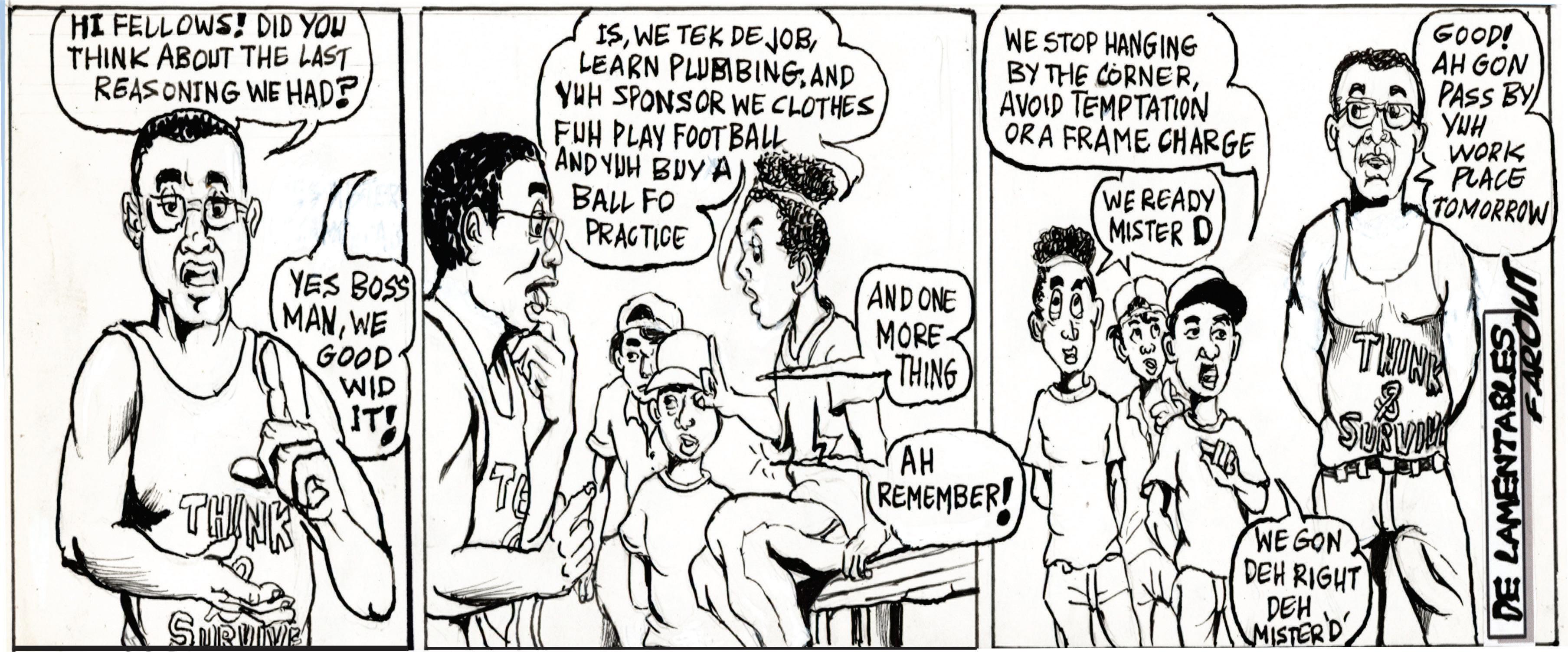
self-deception. They may not know all the right terms and language, but they understand that most of the “money-mandem earn deh cheese legit, and like all de big man dem, now in bad-money scandal. Suh, something ent right,” to put it in colloquial terms.
How do we reverse this?
Based on who is reading
this, do you think that you can convince a generation?
We were all young and suspicious once. We stared at who we termed the ‘salawala’ man, until “De man fulfil E works.”
In his book, The Selfish Gene, Richard Dawkins exhorts natural selection, and natural selection, according

to ‘Darwinism’, is the process that allows the evolved stronger organism to rise and act differently with greater learned strengths than its predecessors to survive. However, in the context of society, though subject to the very laws of social and behavioural evolution, interceptions can develop with a sensible process that must translate itself as believable before further decline, and this requires unorthodox interceptions.
As I interpret it, the concept of evolution exists within the creation formation process, thereby providing room for adjustment and rehabilitation. Thus, our social world is similar. We can detach ourselves from our troubled communities, and blame it on some guilty administrators with justification. But, are we honest in so doing, or are we condoning and consoling ourselves with the inheritance of ‘the selfish gene’?
True, life has become difficult. We hardly have spare time to contemplate our private contentions and threats to sustain our normal sanity. But it is necessary to create a
stage to explore and engage a dialogue that will not be done by any of the institutions we expect to do this. As I was told recently, “that is not in my line of duties.” The truth is that rehabilitation of social ills will offend numerous people who recognise the weight of the task, who will ignore affecting it as long as possible, and instead prefer to pray rather than act, to remain out of the critical zone of serious inadequate officials, but prayer without works is nothing. So, the selfish gene prevails through fear, self-preservation and the absence of know-how.
In closing, The Selfish Gene is multi-active. It will enquire of you, “Why do you want to sacrifice yourself for people who should know better? You’re not here on earth to save the world. Remember you have a family, a job,” all in the effort to turn your back and walk away as fast as you can. It’s safer for them, but what if it raps at your door, and someone within answers and opens it? It could be someone you would have sworn for, but ignored because you prayed and did not observe through works.


SHE opened the door and turned to look back one last time, the pain in her heart like the sharp prick of thorns, and she stifled a sob, feeling the sensation of bleeding. Her hand held an overnight bag firmly, and standing at the doorway where she had stepped through twelve years ago as a young bride, she cried softly, “This was home. That was supposed to be my comfort, my everything.”
Now, she was walking away, for the shattered pieces of her marital life could never become whole again.
In a hushed tone, she bid ‘goodbye’ to the home that had literally been a prison for her. The rich, exquisite décor and antique furnishings, things material, had been her silent witnesses, for within those walls was the secret of an abused woman.
She had heard her own screams so many times over the years, tasted the blood in her mouth from his cruel fists, weakened by fear to stop him. Now, looking at his smiling portrait on the wall, a calm but infuriating feeling flashed in her eyes, for she could see beyond the false portrayal of the evil that characterised his soul.
For two heart-aching hours that night, she had sat by her children’s beds, trying to say ‘goodbye’ as they slept.
“I hope you will understand one day why I had to leave you,” she whispered hoarsely as she kissed their sweet, innocent faces, “It’s better this way than you have to put flowers on my grave. I will come back for you, though, that I promise.”
She had written a detailed letter for them of her thoughts and pain and had hidden it in a safe place so she could one day tell them where to find it.
She closed the door quietly as her husband slept in his drunken state and walked away with laden steps, a broken woman.
A black Tundra was parked a little way down the street, and the door opened
as she approached. A hand reached out to take her bag and helped her in. She sat down in silent grief as the vehicle drove away, aching for her children.
“You’ll be fine,” a comforting voice said beside her. She nodded, fighting back the tears, then looked at the friend sitting beside her.
lor’s Degree in Biology. She had been desirous of working towards solutions to mitigate environmental issues, but something unexpected happened after her first year.
A marriage proposal from a wealthy businessman’s son that found favour with her father threatened to disrupt her studies.

“Thank you, Cassandra.”
Cassandra smiled, giving her hand a gentle squeeze of support, “It’s time for a change in your life, Aanya.”
Aanya took a deep breath and whispered, “I walked away,” as though unable to believe she had made that bold decision.
She and Cassandra had been best friends throughout high school, but after graduation, their lives took different paths. The promising future that they had looked forward to became uncertain because of family issues.
Cassandra’s parents had divorced, and she left her South American homeland with her mother and other siblings for Australia. Aanya enrolled at the University of Guyana to pursue a Bache-
“I am not ready for marriage, father,” she had expressed vehemently, “Especially to someone I don’t know.”
Though a man of strong, traditional principles, her father thought it was a good offer and advised her to consider accepting it.
“This is not right,” she had bemoaned, “It’s my life, but what do I do? Do I walk away from my family or accept the proposal?”
At that young age, she was not prepared to live on her own and had no way of paying tuition for her studies. The businessman’s wealth and status in society, it seemed, impressed her
family more than supporting their daughter in pursuit of her degree, and eventually, she had no choice but to accept the proposal. Life had also taken a bad turn for Cassandra with a wicked stepfather in her life. She had dropped out of college and joined the army to gain strength and fearlessness.
Dreams interrupted; the friends eventually lost contact until their paths crossed a decade later. It was at a cultural event at the Indian Monument Gardens where Aanya’s little daughter was doing a dance performance. Cassandra had just arrived back home on a visit and was attending the same show with her cousin. Aanya did not no-



BEFORE the 19th Century, there was little concern with Occupational Safety and Health. When accidents happened, or a worker’s health was impaired during his work cycle, it was regarded as a normal risk of that occupation and collateral damage. In the 19th Century, as the Industrial Revolution developed in the West, it was gradually realised that the safety and health of a worker were of concern to the employer, since, if there were no accidents in the work situation and the worker was in good health, his production and productivity would increase.
On his part, the worker, with the growth of alternative employment and Trade Unionism, now understood that his health and safety were more in his long-term interest than his immediate wages. The State also recognised that a healthy and productive worker and citizen was an asset to it, and governments began to initiate health-and-safety legislation to protect workers. Various countries have allocated responsibility for the execution of occupational safety and health legislation to various government arms.
In Guyana, responsibility for executing the occupational safety and health legislation has been allocated to the Ministry of Labour, under Minister Hamilton, who has often enjoined workers and employers to closely obey the Labour Laws, including the Health and Safety procedures. The Ministry has mounted educational programmes for both employers and workers, explaining to them the various types of safety equipment required by the various industries, and the necessity for their usage.
Every year, on Occupational Safety and Health Day,
special and comprehensive programmes are arranged with a wider outreach. The provision of occupational safety and health equipment entails a cost to the employer, and many employers are shortsighted and try to avoid their responsibilities, thus endangering or discomfiting their employees. As part of its duties, the Ministry carries out unexpected visits to employers’ premises (“raids”), and employers could be prosecuted if they are found infringing the Law.
The Ministry is primarily interested in cultivating an ethos of Safety and Health in the workplace among employers and workers, and would only prosecute when necessary.
Employers must be prepared to provide health and safety equipment to all their workers, though the requirements for some occupations are minimal.
In Guyana, the main industries in which accidents and deaths are reported are mining, construction, forestry, and agriculture, and each requires workers to be protected by relevant types of equipment. Below, we mention several types of safety equipment and the occupations and industries which should have them:
FIRST AID KITS: All industries should have these.
For some industries, the Kits may be more elaborate. In the aeronautics industry, kits may include emergency water supplies, survival ration packs, flare guns, satellite phones, and reflection mirrors, items not required in other industries.
CELL PHONES: All industries and occupations should carry a fully workable cell phone.
EMERGENCY COM-
PASS: An emergency compass to be carried in aeronautics, forestry, mining and tourism in forests and mountains.
GLOVES: These are to be used in all industries, the type which is relevant to needs of that industry e.g. medical gloves; electrical gloves.
SAFETY BOOTS: Used in the construction industry such as road and building construction and the special type used in the electrical industry.
HELMETS: Used in manufacturing industries, Forestry, Mining and Construction industries
RAINWEAR (BOOTS AND COAT): Whenever a worker has to work in open air.
TORCHLIGHT: Useful in all safety gear.
SAFETY HARNESS AND SAFETY ROPE: Construction Industry, Forestry and Aeronautics.
EAR MUFFS: Wherever there is excessive noise, e.g., in factories, sawmills, or aeronautics.
HIGH-VISIBILITY VESTS: Used when the worker must be kept in sight e.g. Forestry and Aeronautics.
TACTICAL KNIFE: When workers engaged in open-air industries e.g. Forestry and Aeronautics.
PORTABLE FIRE EXTINGUISHER AND SAFETY MATCHES: Useful in many circumstances, both outdoors and indoors.
RESPIRATORS: These are used in occupations where there is a lot of dust, diseased air, and unpleasant smells, e.g., garbage collecting, sawmilling, spraying, and other painting. We have pointed out several safety and health equipment that should be used in various occupations. One such obvious infringement is the garbage collectors, who are not furnished with respirators, and to which the Ministry of Labour should immediately turn its attention.
FROM PAGE XIII
Biological Diversity, Guyana has been actively working through its Environmental Protection Agency (EPA), the national focal point, to fulfill its commitments. The EPA has been pivotal in developing and implementing National Biodiversity Action Plans, including aligning the NBSAP 2015-2020 with the Kunming-Montreal Global Biodiversity Framework (GBF) adopted in 2022. This framework sets 23 global targets for biodiversity protection by 2030, focusing on restoring 30% of degraded ecosystems and enhancing sustainability in agriculture and forestry, as outlined in targets 2 and 10. The EPA has worked diligently to develop standards for restoring and reclaiming degraded lands, preventing the release of contaminants, and conserving and managing associated resources. Additionally, in partnership with the World Wildlife Fund-US, the
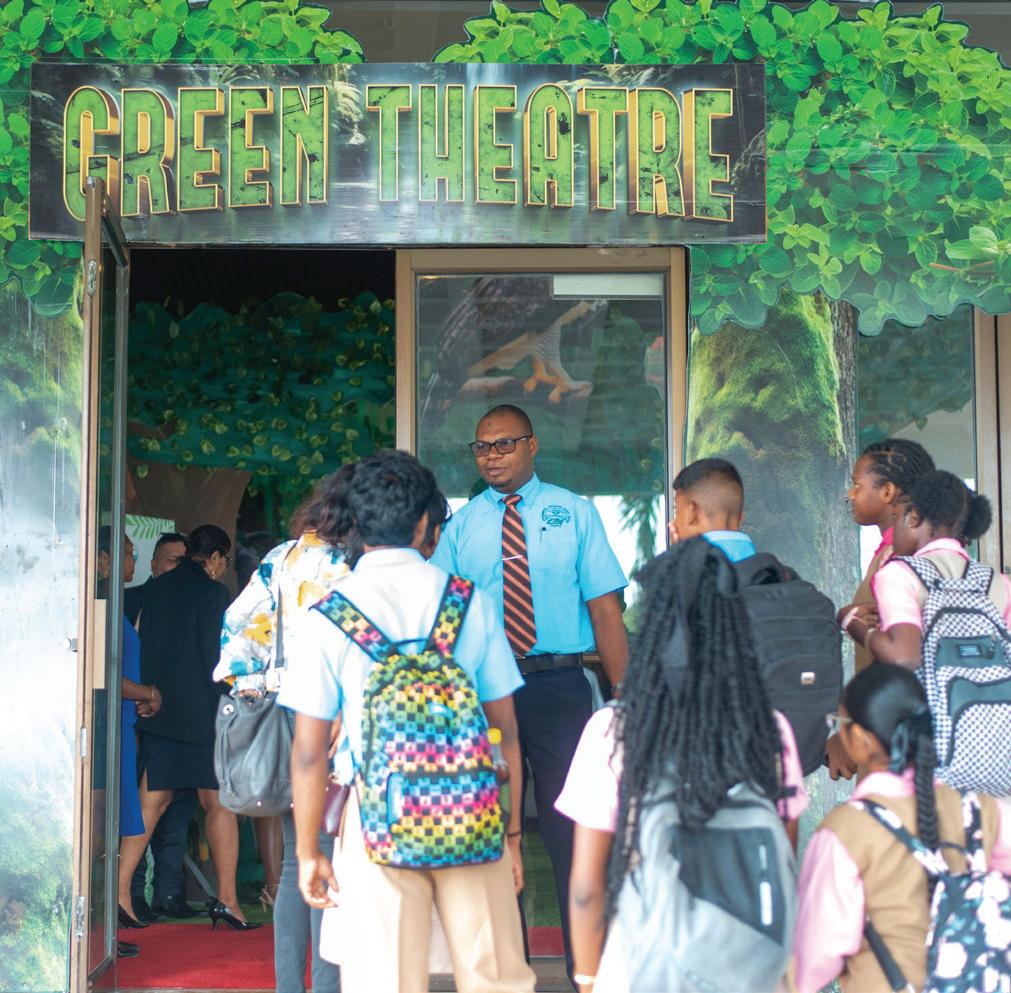
EPA is the executing Agency for the Amazon Sustainable Landscapes Project (ASL), aiming to strengthen landscape connectivity through improved management of the Kanuku Mountains Protected Area and exploring management strategies for the North Rupununi Wetlands. This collaboration exemplifies the EPA’s commitment to land restoration and preservation.
In this spirit of partnership, we urge the public to remember that, together, we can make a difference and preserve our planet for future generations. The environment is everyone’s responsibility. In line with this year’s World Environment Day theme, let’s do our part to restore our land and promote drought resilience throughout Guyana.
The Environmental Protection Agency as part of the celebration of World Environment Day and its 28th Anniversary, hosted the Green Walk on June 2, 2024, which was held in Regions 2, 4 ,6 and 7. This was done with the aim of strengthening the Agency’s presence within those regions. The Agency will continue that trajectory as we conduct our monthly visits in those regions. EPA also held its “Green Theatre 2,” a theatrical production performed for a diverse audience, including Members of Government, the Diplomatic Corp., Heads of Agencies, Non-Governmental Organizations and Schools from across the country. The audience was treated to a drama, dance and poetry production that provided a better understanding of the crucial role and importance of environmental protection.
You can share your ideas and questions by sending letters to: “Our Earth, Our Environment”, C/O Communications Department, Environmental Protection Agency, Ganges Street, Sophia, GEORGETOWN, or email us at: eit.epaguyana@gmail.com. Follow us on Facebook and Instagram and subscribe to our YouTube channel.

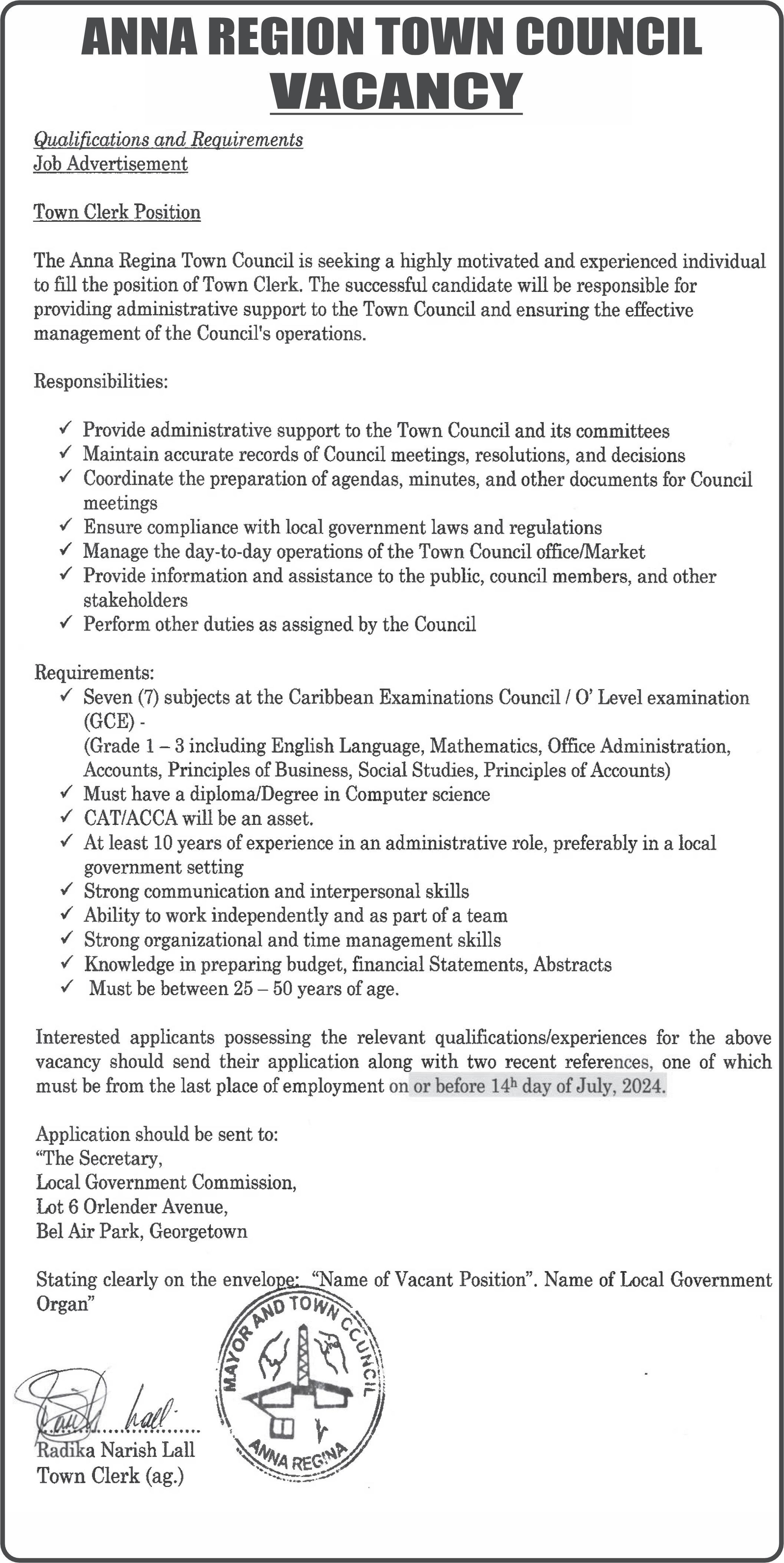
FROM PAGE XV
tice her until a familiar voice called her name, “Hi, Aanya.” She had been chatting with two other parents and turned around, not recognising her old friend at that moment then she gasped with immense surprise.
“Cassandra, oh my god!”
The two friends had hugged, laughing and literally crying, elated at seeing each other after such a long time. Aanya’s husband who was also at the event had walked up with an inquiring look and she had introduced Cassandra, “This is my old high school friend.”
He had shaken Cassandra’s hand with a pleasant smile and informed Aanya they would be leaving now. She had no time to chat a little with her friend and as she gave her a last little hug, Cassandra whispered, “I will see you again, no worry.”
And she did one week later when Aanya went shopping at the supermarket in a mall. There was a food court upstairs, and they sat down, catching up over snacks and cool drinks and reminiscing about school days, fun times, careers, and life as they were now.
A shadow had flickered across Aanya’s face as she spoke briefly about her married life and listened deeply disturbed at her friend’s abuse at the hands of her stepfather.
“I continued my studies during my stint in the army,” Cassandra told her, “so my dream did not get lost.”
“It’s a good thing,” Aanya expressed, “that you found the courage to make that break.”
A short silence fell between the two friends, and then Cassandra asked Aanya bluntly, “When did it start?”
“What?”
“The abuse.”
Aanya didn’t answer for a long moment, then she looked at her friend, lifting the mental veil she had worn all those years to hide her suffering.
“Too long,” she answered quietly.
“Have you ever thought of leaving?”
“Often,” she answered, sighing helplessly, “But nothing was ever in my favour to help me break away.”
“How is that?”
“My husband’s rich and influential family continued to excuse his wrongs, my family can’t help me, and I’m not even free to file a report of abuse.”
She had felt trapped with nowhere to go, no financial security of her own and he had often threatened to kill her should she dare to leave him.
“That’s a literal hell you’re living in. How long more are you going to take it?”
“What can I do?” Aanya had asked, desperation in her voice.
Cassandra covered her hand with hers in comfort and support and promised, “I will find a way to help you.”
Two weeks later, they met again at the food court, and Cassandra outlined to her the work she could get involved in as an environmentalist in the country’s interior regions, which has been Aanya’s lifelong passion.
“You would be on my team, and you get to travel to other countries and network with more people on environmental issues.”
A light had shone in Aanya’s eyes, hearing about those wonderful opportunities then it faded away.
“If I walk away,” she said, “It means I will have to leave my children so he doesn’t hunt me down.” Cassandra touched her hand and said, “If you want a change in your life, to build your strength and self-confidence, you must be willing to make sacrifices. At least you will get to see your children again one day.”
She had smiled wryly, unable to imagine being away from her children at their young age.
“I will think about it.”
The breaking point for Aanya had come one night when her husband, in a fit of rage, had almost killed her. Her children’s terrified screams were the last thing she had heard before everything became dark. Three days later, she had called Cassandra, “I need to leave. Please help me.”
As the vehicle drove further and further away, leaving the hell behind that she had been living in, Aanya sighed deeply, for it was time to take control of her life and change its course, and she said quietly, “It begins now.”
To be continued

HAVE you ever considered why we cannot trace our ancestry names or gene lines? It’s quite unfortunate. This is not a fault of ours or our parents. The act of slavery that happened over two centuries ago still affects their descendants to this very day. This loss of ancestry identity is a result of that. I always wanted to do one of those ancestry DNA tests to determine my identity. I’m a mixed Guyanese, so my identity is a mix of various cultural and ethnic backgrounds. Knowing who or where my ancestors came from would be interesting.
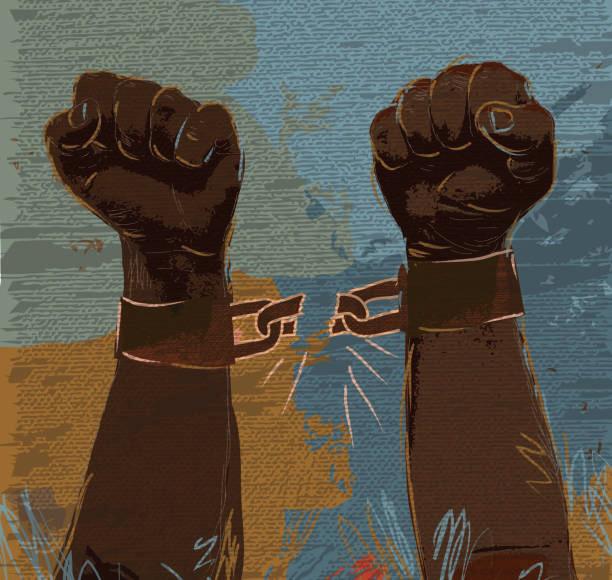
I observe other cultures and ethnicities preserving their culture through pictures, lists, or artefacts in the news or on the internet. I can’t help but feel a bit of anger that the same sentiments cannot happen for some—myself included. Many of our ancestors were taken from their birth lands of Africa, India, China or Madeira and brought to unknown lands. Yes, their descendants now call these unknown lands “home,” but it has forged a way for a new, mixed identity. I cannot leave out the details of our Indigenous brothers and sisters. This was once their home only. However, their identities were merged or otherwise converted.
These days, most indigenous communities in Guyana still remain in the hinterland and inland regions. They maintained much of their language, clothing, rituals and food. The Indo-Guyanese have also managed to maintain most of their identities and some of the language. In fact, down to the family names of the Indo-Guyanese people are still the same. Unfortunately, for the Afro-Guyanese, a lot of their culture was changed. Most Afro-Guyanese have their ancestors’ slave master’s names as their own. Their original language and culture is no longer practised. Most Afro-Guyanese are Christians, but they still managed to maintain ritualistic practices and certain foods. Each ethnic group in Guyana was affected by colonisation—some worse than others. Even the language you’re currently reading this column in is not our ancestral language.
Nonetheless, those delicate and diverse cultural traditions and practices that still exist today should always be preserved and protected. These days, most ethnic groups in Guyana have a shared, common “Guyanese culture”. However, it is essential to remember our individualistic traditions and customs for further diversity and growth. Each of our ancestral roots has different stories. Each is just as significant to what we now know as “Guyanese Culture”. As such, we are responsible for continuing to teach and understand the lessons history can provide.
History was never kind to our ancestors. In return, their descendants (us) were left without our original family titles, origin or even status. The next time you want to compare yourself and our country to other developed people or countries—remember that our lack of growth is not entirely our fault. Most of the consequences regarding any stagnation in our social development, particularly in relation to our identity, are a result of colonialism. As such, I hope you keep this column in mind and be kinder to yourself. Many of our ancestors did not choose this and, by extension, neither did we.







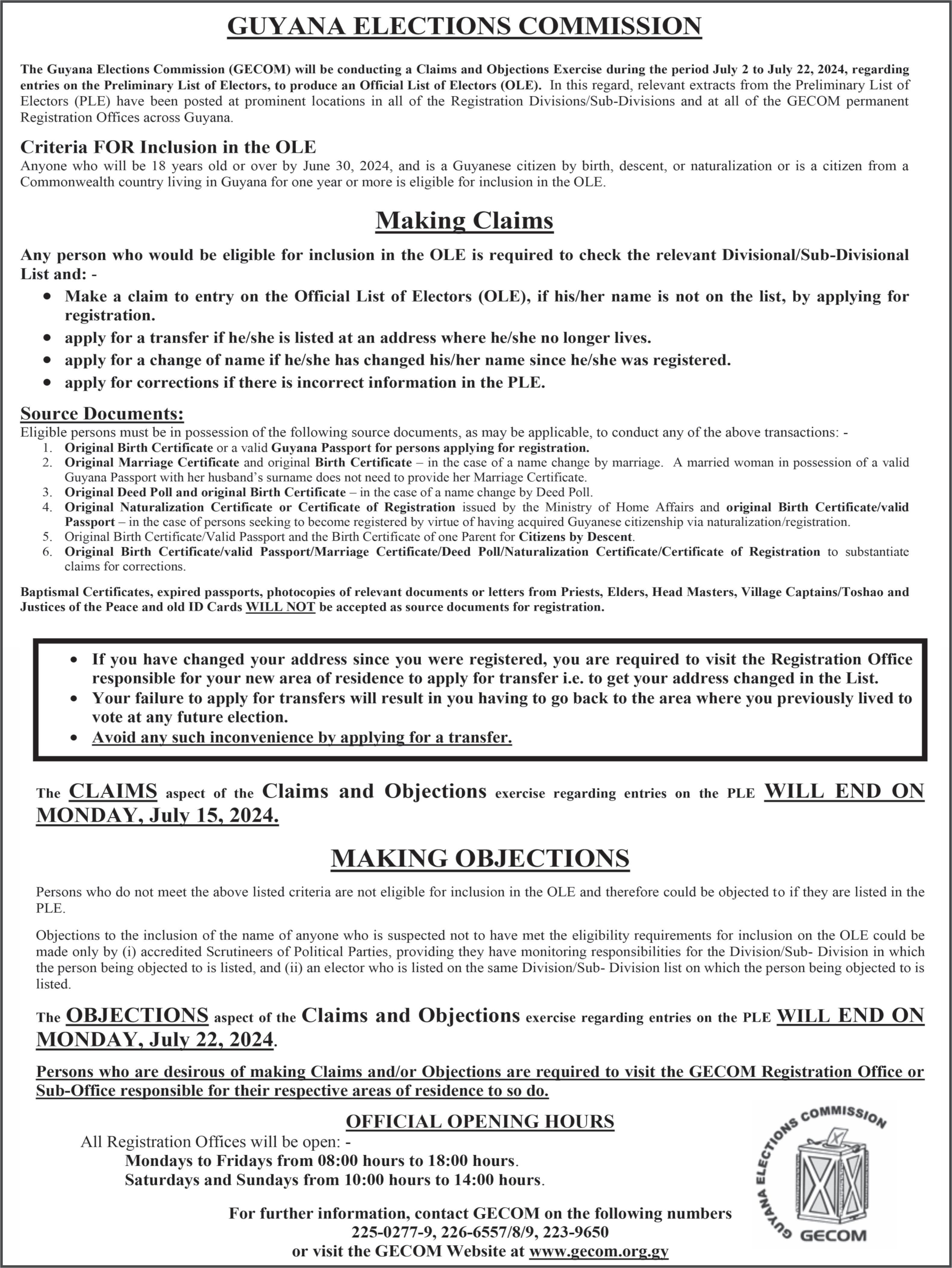

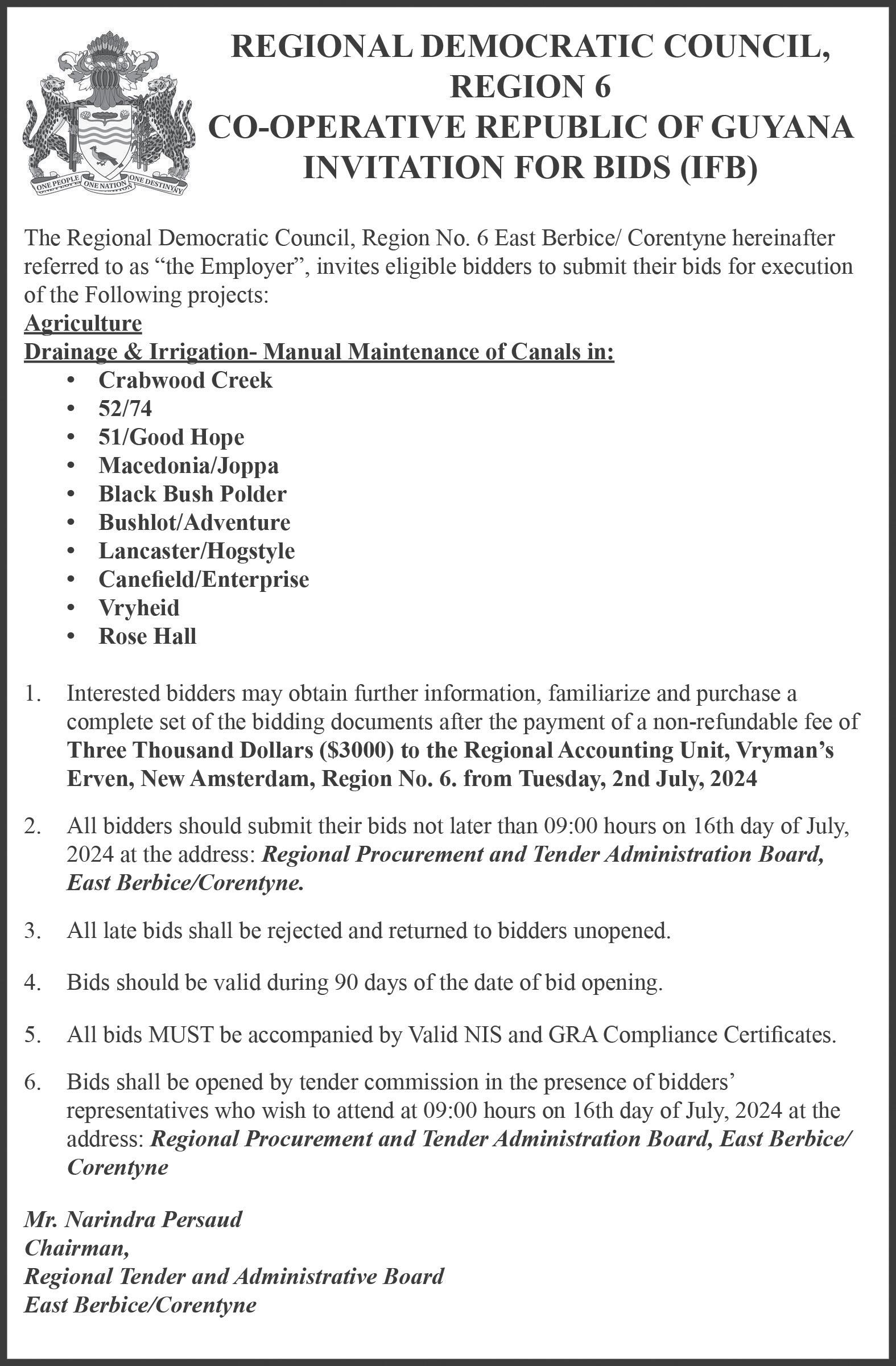

























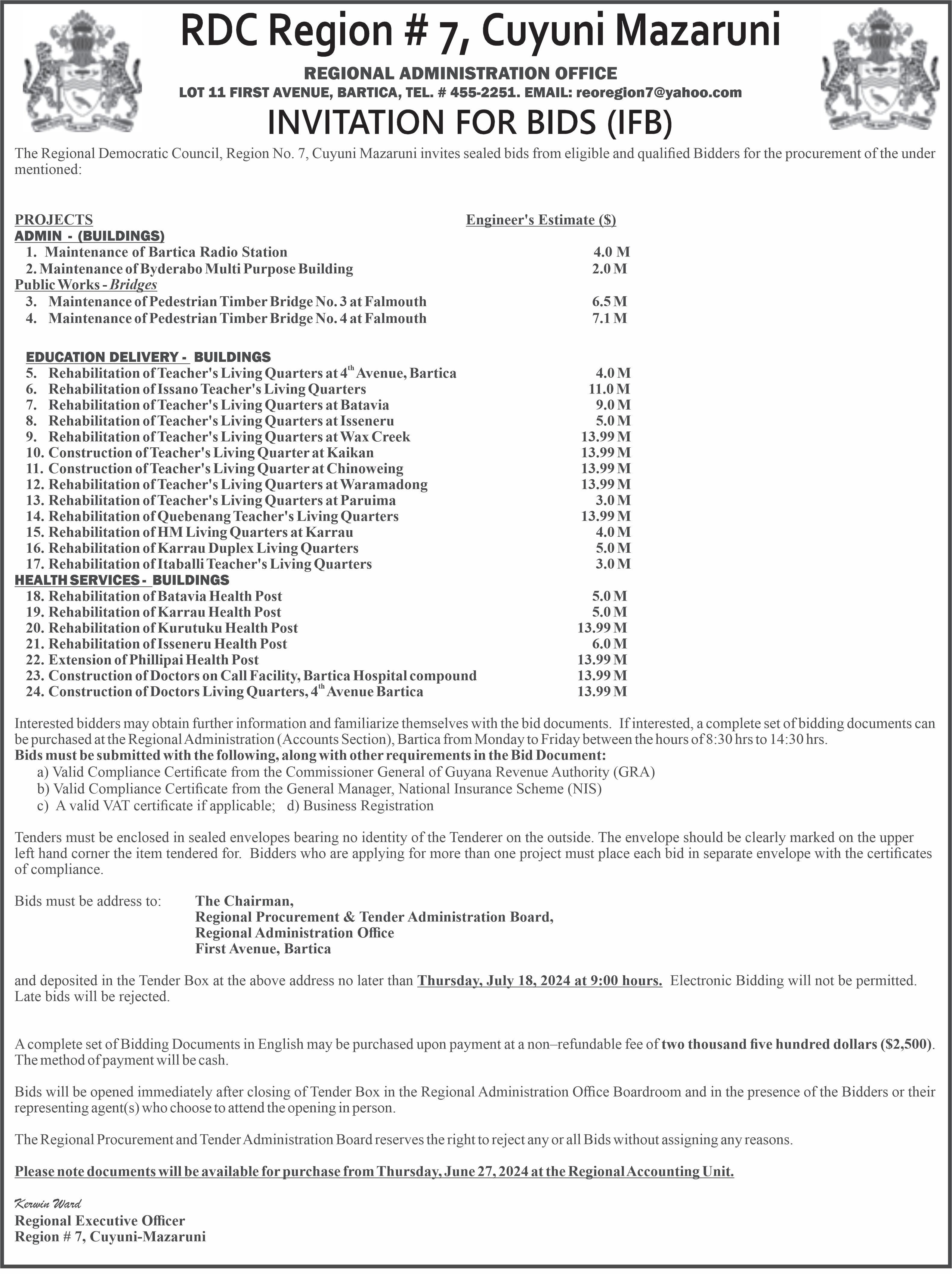


The last temptation is the greatest treason: To do the right deed for the wrong reason
T.S. ELIOT
(1888-1965) Murder in the Cathedral, part 1 section 5
Dear Student,
Welcome dear friend.
Think about matching activities you master thatshow understanding ofa text.Maybe you can match paragraphs, characters or events to pictures or drawings,and can also match text information to graphs or charts. So,when it comes to matching the
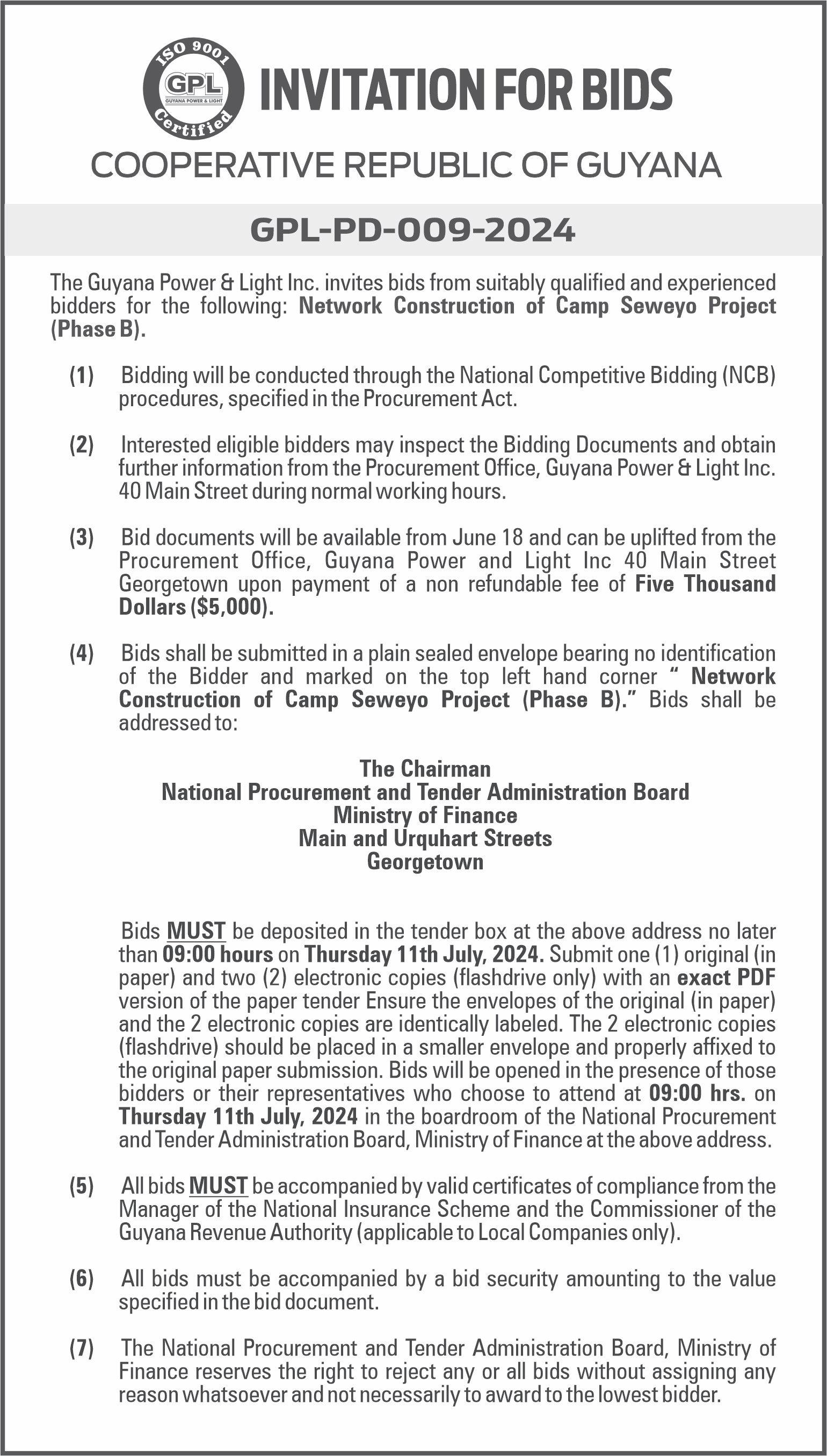
structure of longer texts to an illustration,it should not be problematic. In such case, the accompanyingillustrationsrepresent ways authors organise information. Just consider thegiven text structure entirely and then choose the matching illustration.Be wise.
Love you.
GRAMMAR
Improving sentences structures
A. Pronoun reference
Reminder: A pronoun is used in the place of a noun and the noun is the pronoun’s antecedent for it stands in the place of the noun or noun substitute.
For mixed examples (The latterstructures highlight the use of indefinite pronouns):
1. The play was popular because it drew large crowds.
2. The music scholar chose the philharmonic orchestral video that he had always wanted.
3. Chariton and Fraser rode past the Bible store where they had bought their Easter presents.
4. Everyone needs his health.
5. Each of the workers does her share.
6. Each of the women does her share.
7. Everyone should keep herself healthy. (“Everyone” is a singular subject and as such the verb and personal pronounmustagree and be singular: Everyone or Every person.)
Note: Certain indefinite pronouns are singular. They include these: another, anybody, anyone, each, either, everybody, everyone, neither, nobody, no one, somebody, someone.
In all the following sentences, pronouns fail to be used correctly. Correct the sentences and read them aloud to yourself.
1. Everyone must make (their, his) own bed.
2. Neither Josephene nor Baby had brushed (their, her) hair.
3. Each male patient must present (their, his) next of kin.
4. Another of the players has sprained (their, his) ankle.
5. Either of the athletes may be called on to give (their, his) speech.
6. Does everybody have (their, her) ribbons?
7. Nobody can leave before (their, his) equipment is clean.
8. Every father must provide for (their, his) own child.
B. Word nearest in meaning
In each of the sentences, there are some underlined words. Choose a suggested answer which is nearest in meaning to the underlined word.
1. Although some words and forms of address are archaic and not much used, most people still understand what they mean.
(A) old-fashioned (B) unacceptable (C) misused (D) unconventional
2. During the final stages of the trial a new witness was called to corroborate the testimony of the charged.
(A) clarify (B) confirm (C) conclude (D) compliment
3. During the thunderstorms last weekend, the wind blew incessantly across the middle of our town.
(A) noisily (B) furiously
(C) constantly (D) occasionally
4. My stricken family thanked the friendly cleaning crew for their benevolence in clearing the thickly grown bush from our entire property.
(A) kindness (B) courtesy (C) tolerance (D) friendship
THE POEM
The voice in a poem.
Note: The speaker may be the poet or a character created by the poem’s writer. It may also be a thing or an animal. Read each poem with understanding.
And I think it no disgrace
To occupy my place.
If I am not as large as you, You are not as small as I, And not half as spry.
I’ll not deny you make
A very pretty squirrel track; Talents differ; all is well and wisely put;
If I cannot carry forests on my back, Neither can you crack a nut.
(Ralph Waldo Emerson’s “Fable”)
Something to Do
Identify the speaker in the poem. (It brings understanding to the poem’s meaning.) Explain your answer to a study partner.

NUMEROUS international reports have established and even confirmed that there is a global trend of increased longevity among the elderly, especially in developed and developing countries. It, therefore, seems logical to assume that dentists will continue to enrich the quality of patients’ lives via traditional techniques of prosthetic rehabilitation. However, population groups exist that simply cannot benefit from current treatment techniques.
Many elderly patients already have no natural teeth and wear complete dentures with different degrees of success. Many elderly patients are edentulous (missing teeth) and may be unable to avail themselves of methods for retaining their remaining teeth. Clinical wisdom would suggest immediate denture therapy for such patients particularly if advanced gum disease is present.
For people who have lost most of their teeth to obtain this satisfaction with dentures, it is important that the remaining teeth be preserved no matter what condition the crown may be. If strategically located, these teeth may be retained and prepared for abutment service as adjunctive means of support under partial or complete overdentures.
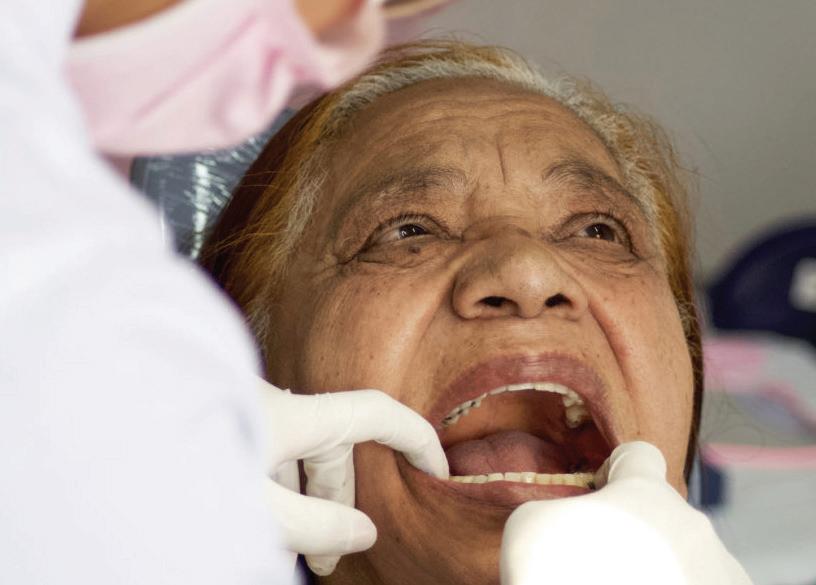
When correctly applied, the mechanical principles of partial or complete denture treatment are purported to virtually guarantee a happy coexistence between dentures and their host tissues. As a result, dentists have been remarkably successful in convincing themselves, if not always their patients, that technically well-made removable dentures can be worn satisfactorily and perhaps even indefinitely.
According to reports, evidence reveals that while it is difficult to define denture satisfaction, a significant number of patients in all age groups are dissatisfied with their dentures. Furthermore, many elderly patients have trouble attaining comfortable and efficient oral function with removable dentures.
The important relationship between adequate oral function and proper digestion and nutrition is well documented. Since the greater the life expectancy of toothless patients is likely to increase, the risk of denture dissatisfaction and its functional implications can only be prolonged. This risk is particularly compelling in the context of denture-supporting tissues’ vulnerability to adverse changes because of longterm denture wear.
There seems to be a tendency for the all-or-none rule where retaining teeth is concerned. It is commonly believed that it is better to extract all one’s teeth and wear total dentures rather than keeping a few and wearing a partial one; well, that belief might have been justified twenty years ago, but not today.
Modern dentistry has made sure that elderly patients with no teeth are by no means in an irremediable situation, no matter how hopeless their condition might appear. Various techniques, albeit somewhat inaccessible to the average person, exist that can significantly take care of seemingly impossible circumstances. One such method is placing mini-implants to semi-permanently retain complete or partial dentures.

